

A Simple Guide To Hybrid Bike Gearing (3 Key Questions!)
June 24, 2022
Erik Bassett
Last updated: December 12th, 2022
Hybrid bike gearing can be a little mystifying as a new rider.
For some of us, it’s about getting the widest possible range to cover everything from steep dirt climbs to sweeping descents. For others, the goal is just to get to work or buy groceries.
Those scenarios have different implications for gearing. What suffices for a commuter will leave an adventurer struggling; what works for back-roads exploration will be overkill for urban use.
By the end of this article, you’ll understand how to think about gear choices, so you end up with a hybrid that suits how you actually ride .
This article might contain affiliate links. As a member of programs including Amazon Associates, I earn from qualifying purchases.
1. How many gears do hybrid bikes have?
A few hybrids have only 3 speeds, but most have between 7 and 27. You’ll often see 1 front x 7-8 rear at the entry level versus. Mid-range models typically have 2-3 front x 8-9 rear, for a total of 16-27.
Single-speed hybrid bikes are very rare. It’s tough to pick just one gear ratio for all situations—unless you have no hills, headwinds, or cargo.
When there are two or more chainrings, gears in the middle tend to overlap. So, while 27 speeds sounds almost overwhelming, perhaps 1/3 to 1/2 of them are not actually unique.
Lately, many high-end hybrids have just 1 front x 11-12 rear.
It sounds counterintuitive that more expensive bikes would have fewer gears. However, the key is their ultra-wide-range cassettes , which can match the total gear range of traditional 27-speed drivetrains.
For instance, a single chainring with a wide-range, 11-50 cassette offers similar overall range to a traditional triple chainring and 12-28 cassette….yet it has only one derailleur to maintain (and to think about while riding).
2. Are more gears better on a hybrid?
Yes, but only to a point. Gear range determines versatility, so more gears are only better to the extent that they increase range. That relationship isn’t consistent, since modern 1x drivetrains can have equally wide range with a lower number of gears.
As I mentioned earlier, a hybrid with a 1 front x 12 rear drivetrain probably offers more range than a traditional 2 front x 8 rear (or similar).
Fewer gears, yet better!
The only catch is that getting a derailleur to work well across 11 or 12 speeds requires more complex and costly designs.
So, while wide-range 1x drivetrains are simpler to use than their 2x/3x counterparts, they also cost more . That’s why 1×12 is ubiquitous on top-end hybrids, but 1×7 and 2×7 are the entry-level norms .
3. How many gears does your hybrid really need?
Seven speeds is plenty for most hybrid bikes in urban settings. If you plan on off-road riding, huge climbs, or heavy cargo, then choose at least 14 with a double/triple chainring or 10 with a single chainring.
Wide-range, 3-speed hub gears suffice for city use. But they cost more and weight more than derailleurs, so they’re not common on hybrids.
Here’s what matters more than gear count
Not to belabor the point, but remember that the number of gears is just a proxy (at best) for gear range . That’s essentially the difference between the highest and lowest. Wider range means you’ll be comfortable tackling a wider variety of hills.
There are a few ways to measure gear range objectively.
My favorite is to compare “gear inches.” That’s the number of inches your bike rolls forward with each full pedal rotation. I like this approach because it accounts for tire size, so you can more easily compare different bikes.
To calculate gear range, pull up any hybrid bike’s tire and gearing specs (available from the manufacturer) and plug them into a gear inches calculator . Then, simply look at the highest and lowest numbers in the table.
Here’s where I’d start out:
- Roughly 60″-70″ is appropriate for flat areas , so that’s where middle gears tend to fall.
- A low around 30″-35″ (at most) is nice for steep climbs . Go even lower for heavy loads and/or steep unpaved roads.
- A high around 90″-95″ (at least) is helpful on descents . You can always coast if you run out of gears, so this is less critical than a sufficient low gear.
These are just rules of thumb from my own experience. It’s worth test-riding everything you can , then plugging in some numbers to find the commonalities.
Finding the ideal gearing for your hybrid
More gears or a wider range generally cost more, so the “best” gearing is whatever covers your real-world riding. That’s a very narrow range for some people, but an enormous one for others.
If you’re one of the many who use a hybrid for bike commuting, then 7 speeds should do the trick. If you’re more of an all-terrain adventurer, then you’ll want a wider range than 7 gears can provide.
To reiterate, the point isn’t the number of gears alone. Modern 12-speeds actually offer more useful range than some traditional 27-speeds. That’s why, as we saw above, calculating actual gear inches is the most helpful thing you can do!
In other words, what counts is having a sufficiently high high and low low , starting with the rules of thumb I’ve shared above. Whether your bike provides that range through 7 or 12 or 27 speeds will affect cost, but won’t affect your enjoyment.
Understanding Hybrid Bike Gears: A Beginner’s Guide
Hybrid bikes are a great choice for riders who want the versatility of a road bike with the comfort and durability of a mountain bike. However, with so many gear options, it can be overwhelming to understand how to use them effectively. In this beginner’s guide, we’ll break down everything you need to know about hybrid bike gears.
What are Hybrid Bike Gears?
Hybrid bike gears are the set of cogs and chains on the bike that allow the rider to shift to different speeds. The gears are connected to the pedals and the rear wheel, allowing the rider to control the amount of resistance or ease when pedalling. Hybrid bikes typically have two sets of gears – the front gears and the rear gears.
Understanding Front Gears
The front gears, also known as chainrings, are located next to the pedals and are controlled by the left gear shifter. Hybrid bikes usually have two or three chainrings, each with a different number of teeth. The number of teeth determines how hard or easy it is to pedal the bike. The smaller the number of teeth, the easier it is to pedal, while the larger the number, the harder it is to pedal.
Understanding Rear Gears
The rear gears, also known as the cassette or freewheel, are located near the back wheel and are controlled by the right gear shifter. Hybrid bikes usually have between seven and ten rear gears, each with a different number of teeth. The number of teeth on the rear gears determines how much the resistance or ease is when pedalling. The smaller the number of teeth, the easier it is to pedal, while the larger the number, the harder it is to pedal.
How to Shift Gears
Shifting gears on a hybrid bike is a simple process, but it’s important to know when and how to do it. When you shift gears, the chain moves from one chainring or cog to another. To shift gears, you need to use the gear shifters on the handlebars. The left shifter controls the front gears, while the right shifter controls the rear gears. To shift to an easier gear, such as when going uphill, you’ll want to use a smaller chainring in the front and a larger cog in the rear. To shift to a harder gear, such as when going downhill, you’ll want to use a larger chainring in the front and a smaller cog in the rear.
Tips for Shifting Gears
Shifting gears can be tricky at first, but with practice, it will become second nature. Here are some tips to keep in mind:
- Anticipate changes in terrain: Before you hit a hill or a steep incline, shift to an easier gear. Likewise, when you’re going downhill or on flat terrain, shift to a harder gear.
- Avoid cross-chaining: Cross-chaining is when you use the largest chainring in the front and the largest cog in the rear, or the smallest chainring in the front and the smallest cog in the rear. This puts extra strain on the chain and can cause it to wear out faster.
- Shift before you need to: It’s easier to shift gears when you’re pedalling lightly. Don’t wait until you’re struggling to shift gears.
- Use your ears: If you hear the chain grinding or making noise when you shift gears, you’re likely cross-chaining or not shifting properly.
How to Shift Gears on a Hybrid Bike
Now that we have a basic understanding of the different components of hybrid bike gears, let’s take a look at how to shift gears. Shifting gears on a hybrid bike may seem daunting at first, but it’s actually quite simple once you get the hang of it.
To shift gears on a hybrid bike, you’ll need to use the shifters on the handlebars. The right shifter controls the rear derailleur, which moves the chain up and down the cassette, while the left shifter controls the front derailleur, which moves the chain between the chainrings.
To shift to a higher gear (harder to pedal), use your right shifter to click up to a larger cog on the cassette. Whereas, to shift to a lower gear (easier to pedal), use your right shifter to click down to a smaller cog on the cassette.
To shift between the chainrings, use your left shifter. The smaller chainring is used for easier gears, while the larger chainring is used for harder gears. To shift to a lower gear on the front chainring, use your left shifter to click down. To shift to a higher gear on the front chainring, use your left shifter to click up.
It’s important to note that you should avoid cross-chaining, which is when the chain is at an extreme angle between the chainrings and cassette. This can cause excessive wear on the chain and cassette and may even cause the chain to fall off.
When shifting gears, it’s also important to ease off the pedals momentarily to allow the chain to shift smoothly. You should also avoid shifting gears under heavy load, as this can cause damage to the chain and cassette.
Tips for Maintaining Hybrid Bike Gears
Keeping your hybrid bike gears in good working order is essential for a smooth and enjoyable ride. Here are some tips for maintaining your hybrid bike gears:
- Keep your drivetrain clean: Dirt and grime can build up on your chain and cassette, causing shifting problems. Regularly clean your drivetrain with a degreaser and a brush to keep it running smoothly.
- Lubricate your drivetrain: After cleaning your drivetrain, be sure to lubricate it with a good quality chain lubricant. This will help to prevent rust and corrosion and keep your gears shifting smoothly.
- Check your cables: Over time, your gear cables can stretch or become frayed, causing shifting problems. Check your cables regularly and replace them if necessary.
- Check your derailleur alignment: If your gears are not shifting smoothly, it may be due to a misaligned derailleur. Use a derailleur alignment tool to check and adjust the alignment if necessary.
- Have your bike serviced regularly: It’s a good idea to have your bike serviced by a professional mechanic at least once a year to keep it in top condition.
Understanding hybrid bike gears is an essential part of owning and riding a hybrid bike. By familiarizing yourself with the different components and how to shift gears, you’ll be able to enjoy a smooth and comfortable ride. Remember to maintain your bike’s gears regularly to keep them in good working order.
Whether you’re commuting to work, exploring new trails, or just enjoying a leisurely ride around town, a hybrid bike is a versatile and practical choice. By following the tips in this guide, you’ll be able to make the most of your hybrid bike and enjoy many years of comfortable and enjoyable riding.
Why Folding Bikes Are Perfect for Commuting and Travel
Read Blog Post
Can Electric Bikes Be Stored Outside?
How to choose the perfect size folding electric bike for you, latest blog posts, winter riding essentials – helmets for cold weather cycling, diy helmet maintenance – tips for keeping your gear in top shape, the role of helmet ventilation in comfortable cycling, the evolution of bike helmet design – a historical perspective, full-face vs. half-shell – choosing the right helmet style for you.
Beach Cruiser
Limited Editions
Folding Trike
For Seniors
sixthreezero Bags & Panniers
sixthreezero Helmets
Sixthreezero Seats
sixthreezero Apparel
Sixthreezero Water Bottles
Sixthreezero Bells
sixthreezero Phone Holders
Batteries & Chargers
Ebike Displays
Bike Advice
Product Reviews
Assembly Instructions
Choosing A Bike
E-Bikes & Bikes Customised to You
Take Upto 30% Off All Bikes For a Limited Time
Take Your Rides to the Next Level. Download Our App Here
How To Shift Gears On Hybrid Bicycles: Gear Changing Guide For Hybrid Bikes
Jeremy Pollack
Updated On: April 11, 2023
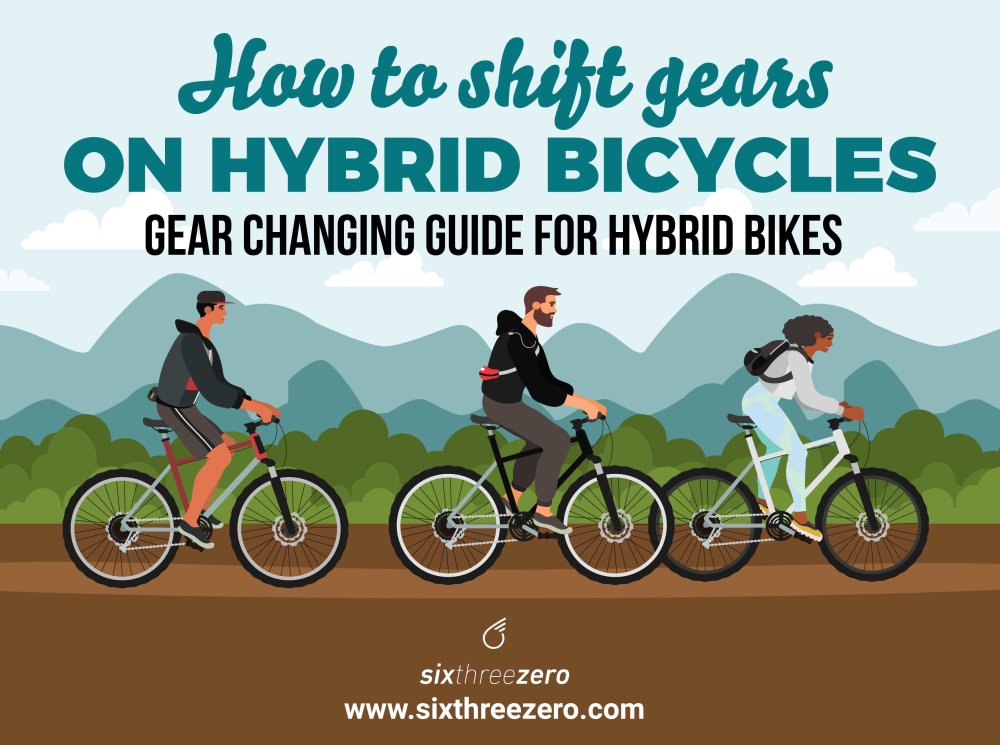
Optimize your ride with gears.
Bicycles are pretty simple devices. Throw a couple wheels on a frame and off you go. Of course, you’ll also want to add some brakes so you can slow down or stop when needed. That’s about it. However, there is one extra ingredient that truly creates that magical flying feeling that only a bike can give. Gears. You could actually get by without gears, but the right bike gear shifter really is the secret sauce that makes riding so fun and easy. Gears make everything better, but it's important to get the right setup for your particular needs

What are gears, anyway?
In the old days, bicycles didn't have gears. Instead, the pedals were attached directly to the front wheel. This works fine for very slow riding, but once you pick up speed, your legs really start spinning out of control. You also get bogged down at a very slow maximum speed no matter how fast you pedal. In order to correct this, bicycles were made with super-huge wheels that yielded more distance per pedal stroke. You know the old vintage photos of bicycles with the ridiculously tall wheels? That was life before gears. They had to make the wheels absurdly gigantic so that the rider could pedal at a reasonable cadence when cruising at the desired speed.
Fortunately, for the future popularity of the bicycle, gears came along and changed everything for the better. Gears take advantage of the principle of leverage and pulleys to allow us to climb steep hills, zoom down hills and even coast when we don’t want to pedal at all. Gears let you set your pedaling cadence independently of wheels and speed, freeing you to go wherever the road or trail takes you.

If you're considering a hybrid, you need gears.
When looking into getting your new hybrid bicycle , gears should be a major part of your decision. Of the many variations that exist in the anything-goes category of hybrid bikes, you'll be exploring preferences in frame geometry (riding position), tire size, and gears. For gears, the first step is to consider why you need the bike and where you will be riding. Take a moment to think about what you want to get out of your new ride. Is it for fitness? Do you need it for commuting to work or class? Perhaps you just want an occasional casual ride when summer rolls around. As a basic rule of thumb, the more serious or important the riding is to you, the more gears you should get. However, you may want to balance extra gears with simplicity or ease of maintenance
Also, give some thought to the terrain and weather that you will be riding in. You can ride on flat land with just one or a few gears, but hills require more gears. Mountainous rides and long distances can demand all the gears you can get. Weather is also very important. Wind and rain can have surprisingly strong effects on how hard or easy your ride will be. If you live in a windy area, having easy gears will let you power through a headwind while faster gears will let you take advantage of a tailwind. Rain, sleet, and snow all serve to slow you down, so it's important to have the option to downshift if you ride in that those weather conditions.

How do bike gears work?
Gears can work a few different ways, but the underlying magic comes from utilizing the leveraging power of pulleys. On a bike, the pulleys are star-shaped cogs called gears. Your pedals turn a large cog called a chainring which in turn pulls a chain that is directly linked to another cog on the rear wheel. This cog, or gear, rotates the rear wheel, propelling the bicycle. By varying the sizes of the chainring and rear gears, bicycles offer different gear ratios to determine how many times the rear wheel revolves per pedal stroke. The end result is an adjustable ratio that makes your ride easier or faster as needed.

Single speeds.
The simplest gearing option is a single speed. These are a great option for casual riding on flat paths, so beach cruisers are the ultimate single speed bikes. The gears can be set up to be either easier or faster, but they cannot be shifted to adjust to changing terrain. Although you will be limited in your speed and range, the minimal equipment on a single speed requires very little maintenance. Some oil on the chain every month or so will suffice.

Internal three-speeds .
Internal gears usually come in the three-speed variety, although five- and seven-speed options can be found. The great advantage of internal gears is that all of the gadgetry is stuffed inside the hub so that the gears are protected from damage and weather. Also, these gears are super easy to operate and require only minimal maintenance. They may only offer a few different speed options, but that may be all you need if the terrain is relatively flat and the riding is just a casual cruise.

Seven-speeds— can you say “derailleur”?
If you’re using your hybrid for commuting, fitness, to cover some distance, or on slopes, you’ll need more gears. Larger gear ranges are not internal. They are operated by an external component called a derailleur that physically shoves the chain onto different gears. The most common gear setup is the good old seven-speed, which has all but replaced your grandfather’s ten-speed. The seven-speed is the simplest derailleur option because it only requires one bike gear shifter for you to operate, repair, and maintain. Derailleur systems require more attention and care than the internal systems do, but the seven-speed is the simplest of these.
To get more than seven speeds, most bikes will have to add a front derailleur and an additional chainring or two. The very capable 21-speed configuration is the most common for hybrids, and it delivers a broad range of gears that can handle just about anything.

Learning how to shift gears on a bike is easy. The hand controls, called shifters, come in two basic varieties. Most hybrids have the twist-style shifting that can be rotated while gripping the handlebars. Other models may have trigger shifters that can be operated with your index finger and thumb. In both cases, gears are numbered from ‘1’ to ‘7’ for 7-speeds, with ‘1’ being the easiest gear and ‘7’ being the fastest gear. 21-speeds have a second shifter numbered ‘1’ to ‘3’. A ‘1’-‘1’ combination would be the easiest gear for climbing steep hills while the ‘3’ - ‘7’ combination allows for maximum speed on the downhills.
The sixthreezero Evryjourney is a great example of how a bike can be outfitted with the exact gearing for your needs. This bike comes in four options ranging from single speed to 21-speeds so that you can get exactly what your riding requires.
As you sort through the many variations that make hybrids so adaptable, make sure to give some thought to the reasons that you want to ride. When you know what type of riding you’ll be doing, you can pick the perfect gears to get that singular flying feeling.

When it comes to shifting gears on your hybrid bike, remember that it's all about finding the right balance between your pedaling cadence and the terrain you're riding on. As you become more comfortable with your hybrid bike, you'll start to develop a sense of when to shift gears based on the conditions around you. Remember to practice shifting gears on flat, even terrain before moving on to more challenging terrain. And always be mindful of the gear you're in, as using too high or too low of a gear can lead to inefficient pedaling and increased wear and tear on your bike. By following these tips and practicing regularly, you'll soon become an expert in shifting gears on your hybrid bike.
© 2024 sixthreezero
Designed in Los Angeles, California
How to Shift Gears on a Hybrid Bike: A Comprehensive Guide
Hybrid bikes are a great choice for those who want a versatile and comfortable ride. Whether you’re commuting to work, exploring the countryside, or just cruising around town, a hybrid bike can handle various terrains and riding styles. However, to get the most out of your hybrid bike, you need to know how to shift gears properly.
Shifting gears on a hybrid bike may seem like a daunting task, especially if you’re new to cycling. But with the right technique and a bit of practice, you can easily shift gears like a pro and enjoy a smoother, more efficient ride. In this article, we’ll provide you with a comprehensive guide on how to shift gears on a hybrid bike, including tips and tricks to help you master gear-changing and enhance your overall cycling experience.
Table of Contents
Understanding the Mechanism of a Hybrid Bike’s Gears
A hybrid bike is a combination of a road bike and a mountain bike. It is designed to be fast on smooth roads and capable on rough terrains. The gears of a hybrid bike are an essential part of the bike’s design to help you ride effortlessly on different terrains.
The mechanism of a hybrid bike’s gears consists of multiple sprockets in the rear wheel and two to three chainrings at the front. The shifter controls the derailleur, which moves the chain onto the desired sprockets. The gears provide different resistance levels to the pedals, making it easier or harder to pedal. Understanding how your gears work is essential before shifting gears on a hybrid bike. Knowing when to shift gears will help you ride in a suitable gear ratio, increasing your speed and reducing the stress on your muscles.
Read Also: What’s a Hybrid Bike and Why You Should Consider Getting One
Choosing the Right Gear Combination for Various Terrain
Choosing the right gear combination for various terrains is important for a smooth and comfortable ride on a hybrid bike. It allows you to pedal efficiently and maintain a steady speed, irrespective of the terrain you are riding on. For instance, on a flat terrain, a higher gear combination will make pedaling easier but with more resistance. On the other hand, when ascending hills or steep inclines, shifting down to a lower gear combination will make pedaling easier and less strenuous on the muscles.
It is important to remember that the gear combination depends on the rider’s level of fitness, strength, and experience. While seasoned riders may opt for higher gear combinations while riding on challenging terrains, new riders may find it more comfortable to stick to lower gear combinations. The key is to choose a gear combination that allows you to maintain a comfortable cadence while pedaling, without putting undue strain on your muscles.
Methods to Shift Gears Smoothly Without Any Jerks
Shifting gears on a hybrid bike can be an incredibly smooth and seamless process if done correctly. However, many riders can make the mistake of jerking the bike, which can be an uncomfortable and jarring experience. There are several methods to shift gears without any sudden movements.
Firstly, it’s essential to make sure you’re in the right gear before shifting. Second, ease up on the pedals to remove any tension before shifting. Third, apply light pressure to the shifters to make a smooth transition between gears. Additionally, timing is crucial when it comes to gear shifting. It’s best to shift gears before the need arises, rather than when you are struggling to push up a hill or downhill. By practicing and perfecting these techniques, you can shift gears smoothly and enjoy a comfortable and uninterrupted ride on your hybrid bike.
You may also like: Top 12 Best Women’S Hybrid Bikes Under $200 to Buy In 2024
Ways to Maintain and Replace the Gearing System on a Hybrid Bike
Keeping the gearing system of your hybrid bike in good working condition is crucial for a smooth and comfortable ride. To get the best performance out of your bike, proper maintenance is needed. It’s recommended to clean the chain regularly and lubricate it after every few rides. You can use a degreaser to remove dirt and grime from the chain, cassette, and derailleurs. After cleaning, you can apply a lubricant to prevent rust and corrosion and improve the bike’s performance.
In case your bike’s gearing system needs replacement, you need to consult with a professional bike mechanic. Most bikes have a replaceable cassette, chainrings, and chain. A mechanic will help you identify whether it’s time to replace the parts or simply maintain them. Regular maintenance and replacement of the gearing system will help you save money in the long run and enhance your rides. A smooth and well-working gearing system will make shifting gears a breeze, providing a more comfortable and enjoyable ride.
Tips to Improve Your Pedaling Efficiency for Better Gear Shifting
Pedaling efficiency plays a vital role in ensuring smooth gear shifting on your hybrid bike. The right technique can help you shift easily and achieve maximum pedal power, but doing it wrong can cause strain on your knees and reduce your cycling performance. Here are some tips to improve your pedaling efficiency:
Firstly, ensure that you maintain a steady cadence while biking. Make sure that your pedaling motion is consistent and your pedal stroke is even. Your bike’s gears need to be used appropriately to ensure that your pedaling and bike’s operation work in sync. Secondly, try to maintain a lower gear while pedaling on a steep uphill. This reduces strain on your legs, allowing you to climb more efficiently. Lastly, avoid being tense or tight while pedaling, as this will reduce your efficiency and limit your ability to change gears smoothly. These tips will help you improve your pedaling efficiency and achieve a better performance on your hybrid bike.
Common Gear Shifting Mistakes to Avoid for a Safe and Enjoyable Ride
Shifting gears is a significant aspect of riding a hybrid bike. Knowing how to shift gears correctly ensures a smooth and comfortable ride. However, committing gear shifting mistakes may cause discomfort and accidents while on the road.
One common gear shifting mistake is cross-chaining. Cross-chaining happens when the chain is at an extreme angle, resulting in undue stress on the chain, cassette, and derailleur. Another mistake is forgetting to downshift before coming to a stop. This mistake may cause the chain to derail when starting to pedal again. Other common mistakes to avoid include changing gears while pedaling backward, shifting gears abruptly, or neglecting to maintain the bike’s drivetrain regularly. Remembering these mistakes and avoiding them during bike rides ensures a safe and enjoyable ride.
Related Post: Top 10 Best Hybrid Bikes For Off Road – Reviews and Comparison
Advanced Gear Shifting Techniques for Experienced Cyclists
Advanced gear shifting techniques require more experience and skill than simple gear changes. Experienced cyclists have developed some techniques that can make them more efficient and effective while riding on a hybrid bike. One such technique is spinning, which is to pedal in a circular motion. This allows a rider to use their leg muscles more efficiently and can help them maintain momentum, particularly in challenging terrain.
Another technique for advanced gear shifting is “granny gear,” which refers to using the smallest chainring and the largest cog for a low gear that is ideal for climbing hills. While this may sound strange, using the small chainring and the larger cog can actually provide more torque, making it easier to climb uphill and tackle other challenging terrain. These techniques must be practiced and should only be attempted by experienced cyclists, but they provide a great boost in speed, efficiency, and overall enjoyment of cycling on a hybrid bike.
Wrapping Up
To conclude, shifting gears on a hybrid bike is a crucial aspect of riding and ensures a smooth and efficient experience. With the right technique and practice, anyone can master the art of gear-shifting on a hybrid bike.
It is essential to keep in mind that each bike is unique and may require different techniques to shift gears. Therefore, it is always helpful to understand your bike’s mechanics and try different methods until you find the one that works best for you. Paying attention to your body’s signals and the environment around you can also help you make the correct gear changes. With patience and perseverance, you can achieve a comfortable and enjoyable ride on your hybrid bike.
Leave a Comment Cancel reply
Save my name, email, and website in this browser for the next time I comment.
- Diamondback
- Sixthreezero
- Critical Cycles
- Sizing Guide
- Hybrid Bike Under 300
- Hybrid Bike Under 500
- Men Hybrid Bike
- Women Hybrid Bikes
- Bike Water Bottle
- Bike Water Bottle Holder
- Best Bike Shoes
- Road Bike Helmet
- Bike Lights
- Bike Jersey
- Bike Saddle
- Cycling Glasses
- Speed Meter
- Cycling Gloves
- Signals Lights
A Starter’s Guide to Hybrid Biking Gears
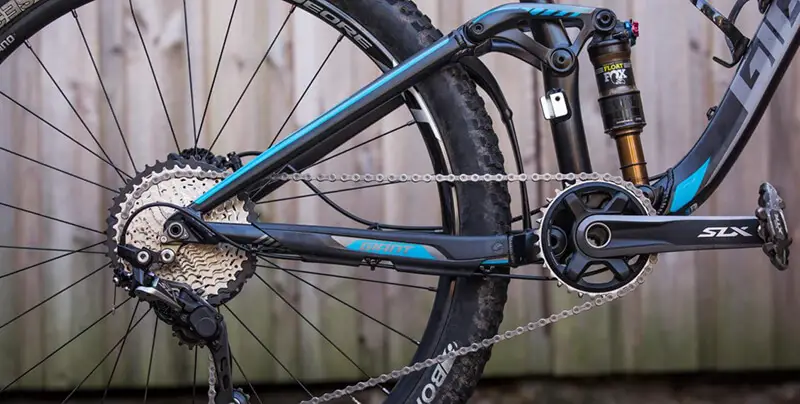
I love how the gymnasts put it; timing is everything! They are right. If you don’t get it right you’d probably miss the grip and break a leg. Your mind should be set way before you take the leap.
If you own the best hybrid bike you must have heard this saying too; timing is everything! If you still don’t know why daddy kept saying it to her little gal, then you’re just about to find out today.
For beginner hybrid bike riders, this mantra holds the key to one of the most important lessons in the best hybrid bike riding. How to change hybrid bike gears. Let’s first look at the guide before revisiting our mantra.
Step I: Understand Your Hybrid Bike
By this I simply mean you should understand your bikes gear mechanism. To do so you should at the following.
- Your drive train; from the chain rings to the free-wheel.
- Make sure you look at the big chain sprockets at the pedals too.
- Master the cluster of sprockets at the rear wheel/ connecting chain.
To have a better view of the whole system, you should wipe off any dried mud and old grease off the metal surfaces. This should leave you with a rough idea of what goes on down there while you’re riding along the trail and jamming thumb levers.
Step II: Learn When and How to Shift
Knowing what goes on below the handlebars when you are busy jamming thumb leavers back and forth in your best hybrid bike is crucial to understanding the when and how to do the shift.
There are many tell tale signs that you could watch out for in order to get your shifting absolutely right. Remember the mantra, timing is key…learn to anticipate before you actually reach there.
- Watch the terrain ahead and shift accordingly a few meters before getting there.
- Don’t wait until the gear is too hard to peddle or too soft to just keep spinning.
- Know your body. This helps to notice the slightest change in workload to shift.
The rule is simple really; always anticipate and choose the gear you’ll need way before you change the terrain from your descent pedaling flat ground. If you don’t and wait until it’s late then trust me, the derivation to your best hybrid bike will be looking at a very short and unhappy existence.
Step III: Make Timely Amends Too
When changing gears on your best hybrid bike, sometimes you might misjudge or fail to anticipate the correct gear. If this happens you can make timely amends by choosing the “soft-pedaling” approach.
This means that you should pedal very hard on one down stroke to gain more momentum that will allow soft-pedaling on the next.
However, you should remember to immediately shift after the powered stroke, since the soft-pedaling during the next few minutes will ease any tension on the bike’s chain allowing the derailleur to move smoothly.
Important Considerations When Shifting Hybrid Bike Gears
We have seen some considerations above. But for a much more in-depth look we the best hybrid bike rider should always go with the following considerations.
Keep all Your Derailleur Well Adjusted
Both the front and rear derailleur should be on point. You can choose a local bike shop and for a small fee get a 10-minute hands-on lesson and proper adjustments too. Additionally, you can buy a book on bike mechanics or read ideal DIY posts online.
Give an Ear to Your Best Hybrid Bike
This simple mean you should listen to your bike and master every sound that it gives. The sounds should include the ones that it will produce when all components are working properly and those that might mean otherwise.
A good example is tuning your ears to notice any form of chain chatter. You can do the same for the other unfamiliar metal-on-metal noises that would mean things aren’t perfectly aligned.
Keep Your Derailleurs Clean/ Lubed.
When you keep your chain clean and lubed you will avoid any forms of rust and strain on the chain. This will prevent cranking and instead it will leave the rotation on your bike’s gears working really smoothly.
Don’t Pick Wrong Gear Combinations
Picking the wrong gear combinations are referred to as cross-chaining. Avoid this mistake by all means. It will put your chain at a severe angle and damage your derailleur fastest.
Like I said, forcing your best hybrid bike derailleurs to shift under load especially when cranking hard is really tough on the bike’s components and your body muscles too; always choose the next gear when still in your perfect riding ground. Yes, “timing is everything” when it comes to changing the hybrid bike gears.
If you succeed in this, together with listening to your bike, you’ll avoid the wearing out of freewheel cassette cogs, chain rings, and derailleur cages among many other things that your bike uses.
Share This Story, Choose Your Platform!
Related posts.
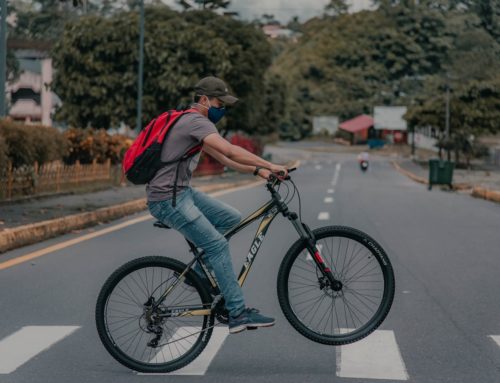
- RWR Home Page
- Recent Posts
- Bike Reviews
2022 Trek FX 3 Review
- by Riding With Ryan (Official)
- 56 Comments

This 2022 Trek FX 3 review covers everything you need to know about the best hybrid bike for 2022. The 2022 Trek FX 3 checks all the boxes: disc brakes, 1X drivetrain, tubeless ready wheels and more! Its a fitness hybrid, which means you can ride it like a flat bar road bike while staying comfortable, or use it to commute around town.
The FX 3 is the best value in the FX series. The FX 1 is heavy because it comes with a steel fork. There are some models of FX 1 that still have rim brakes. The Trek FX 2 has a similar price point to the FX 3, but the upgrades on the 3 are worthwhile. (We dive into those upgrades below!) Regarding the front fork, the FX 2 comes with an aluminum fork, while the FX 3 has a carbon fork. Carbon reduces vibrations, meaning the 2022 FX 3 will provide a more comfortable ride.
Trek FX vs Trek Dual Sport vs Trek Verve
The three most common hybrid bikes in Trek’s arsenal are the FX, Dual Sport, and Verve. Depending on how and where you ride, each model offers a unique set of features. The Trek FX is the Five-Star General for several reasons.
First, in a weight comparison the Trek FX is the lightest bike of these three hybrid models. The Dual Sport comes with a front fork suspension adding a lot of weight. That front fork isn’t good enough to classify the Dual Sport as a mountain bike because it has limited travel. There is more room for wider tires on the Dual Sport than the FX, but again, you aren’t going to fit a set of 2.6″ Maxxis DHF or DHR tires to make a full mountain bike conversion. At best, the Dual Sport is an over-equipped gravel bike.
The Trek Verve is also a heavier bike than the FX, and it doesn’t come with suspension. It still has a similar weight to the Dual Sport. Depending on frame size you can expect your Dual Sport or Verve to weigh in approximately 31-33 lbs, depending on frame size. The FX 3 weighs just 25 lbs, which means climbing hills and going fast will be a lot easier on the FX.
Trek FX 3 Maximum Tire Clearance
Speaking of tire clearance, the Trek FX 3 maximum tire size is listed at 38mm per Trek. Trek believes you need 6mm of clearance on each side of the tire. I run gravel tires that are 40mm wide on my FX 3 during the winter and when I know I will be riding a lot of gravel trails. They provide plenty of traction in all riding conditions, and adding an even wider tire would simply add unnecessary weight to the bike.
All three models come with rack and fender mounts. The only area the Trek Verve has the advantage is in adjustability. The stem is adjustable to an upright position, and dropped for riding aggressively. The adjustment is made with an Allen wrench. On both the Dual Sport and FX, you need to flip your stem for any adjustability. Even then you aren’t getting the same amount of adjustment range offered by the Verve.
Trek FX 3 Upgrades
There are a few upgrades covered in this 2022 Trek FX 3 review that you need to make before leaving your bike shop. The three main touchpoints almost always need an upgrade with any new bike. They are grips, pedals and saddle. This is the first new bike I’ve purchased that I am not upgrading the grips. The 2022 Trek FX 3 comes with Bontrager Satellite IsoZone Plus grips that are lock-on and ergonomic. IsoZone is a vibration dampening technology and simply put… it works.

2022 Trek FX 3 Touchpoint Upgrades
When it comes to pedals, I am an advocate for clipping-in. Clipless pedals are a must have, but even cyclists that ride flats will want to upgrade pedals on their Trek FX 3. The Bontrager City pedals do not have a lot of grip, and they are cheap plastic that isn’t durable enough for even a casual rider. I don’t believe one clipless pedal manufacturer has an advantage over the other. You should use the pedals that are easiest to get in and out of. Most bike shops will let you test a few options to help you decide.
The saddle on this bike is nice. Most beginner cyclists will complain it is too hard, but the firmness of the saddle provides increased efficiency. Also, soft saddles become more uncomfortable on longer rides, and once you buy a Trek FX 3 you will go on some long adventures. Rather than upgrading the saddle, try a pair of cycling shorts. If your concerned about the look, you can always throw a pair of casual shorts over top. The built in chamois cycling shorts offer is the number one way to increase comfort on your bike. My personal favorite is the Escape Quest short from Pearl iZUMi. Its a durable cycling short that costs $50 or less. ( Check Current Price on Amazon Here ).
2022 Trek FX 3 Tire Upgrades
As I mentioned previously, a good set of winter tires is a must for this bike if you plan on riding in all weather conditions. I really love the 700×40 Donnelly Gravel Tires. If you plan on riding a lot of gravel I highly recommend a tan sidewall. They hide the dust better than all black tires, and they look great. ( Check Current Price on Amazon Here ). The FX 3 comes with tubeless ready wheels, and the Donnelly tires are tubeless compatible.
Tubeless wheels and tires allow you to run a lower tire pressure without having to worry about getting a flat. Tubeless setups are also lighter than running tubes, so you cut weight off the bike which adds to your efficiency. Converting to tubeless is something I recommend doing before you leave the bike shop.
2022 Trek FX 3 Drive Train
Another reason I upgraded from my 2020 FX 2 to this 2022 FX 3 is the drive train. Like it or not, the biking industry is moving to simplified drive trains. That means getting rid of your front derailleur. Your rear cassette is manufactured with enough range that 2X and 3X drivetrains are obsolete.

The 2022 FX 3 comes with a 1X10 Shimano Deore drivetrain. Shifting is incredibly smooth, and there is plenty of range for climbing mountains in Colorado. With the high end drive train, carbon fork, and thoughtful upgrades the price is $150 more than the FX 2 (Read: Trek FX 2 Review ), but the upgrades make the FX 3 an incredible value. The carbon fork alone is enough to justify the added expense, and the upgraded drivetrain makes the FX 3 a no brainer.
With the upgraded drivetrain you need to be able to stop faster too. Stopping is no issue with this bike thanks to the hydraulic disc brakes from Shimano. Disc brakes make stopping easier and faster in all weather conditions. There is no debate on the better brake, because disc brakes work better than rim brakes in every scenario.
If you enjoyed this 2022 Trek FX 3 review, consider reading:
- 10 Ways To Make Your Bike Lighter
- Best Road Bike For Beginners
56 thoughts on “2022 Trek FX 3 Review”
Hello, I’m very interested in the FX 3 before I buy can I get the handlebars up a few inches with an adjustment or replacing the stem with a longer one. Btw Your video was great I will go tubeless as u recommend. Thank you , Charles
Yes there are stems available that sit higher, but if you want a gain of a few inches you will be better off replacing the bars. The amount of gain you get from adjusting the stock bars is only a centimeter or two.
Loved your review and ended you getting the bike, same color, thank you. Quick question, could you provide info on the water bottle holders? I love how they complement the FX3, both black and blue.
I went with the Bontrager Elite bottle cages because I knew the colors would match. I can’t remember the name of the blue, I just know it was NOT the Waterloo Blue.
The color is alpine blue.
Yes! Thank you!
Hi Ryan, Thanks for the review. I’m debating between FX2 and 3 (or even Dual Sport). Most of my rides will be on city roads, but my commute does have a few hills (yikes San Francisco!) and I do plan to ride on light trails and gravels occasionally. What would you recommend for this riding situation?
Thanks, Abota
I definitely recommend the FX 3. The Carbon fork on the 3 will be a big advantage over the FX 2 when you hit that occasional gravel, and the weight savings over the Dual Sport will serve you much, much, much, mmmmuuucccchhhh better than the Dual Sport on those hills. If you are worried about the comfort of the rigid frame you can always put a higher volume tire on the FX to get you more comfort.
Is this bike comfortable for uphill riding with stock tires ?
Yes, it definitely is.
Do you ever use fenders? I’m curious if fenders still fit with your 40mm tires, which Trek says is already above the max of 38mm without fenders. Thanks!
I don’t use fenders on my FX. I think with fenders it’s best to stick with treks recommendation because there isn’t as much extra clearance. I’m going off memory but I think with fenders max tire width is 35mm.
Hello Ryan, I am thinking of upgrading my 2022 Trek FX3 Disc to a 2x system. What are your thoughts?
To each their own. If you feel like your ride is less enjoyable because you don’t have enough gearing for your terrain, then it’s a good idea. I would challenge you to go for a ride and tell yourself before hand that you will enjoy your ride even if that means working a little harder or going a little slower. I think you will find after a handful of rides the 1x is pretty good.
Hello again Ryan, I got a bit of a paint chip on the top tube in the aqua blue part of my 2022 FX 3 Disc. Can this easily be fixed on your own or should I take it to a bike shop?
It depends on how you want it to look. Its really hard to color match and blend it yourself. If you take it somewhere it will probably cost a small fortune.
Ryan, I’m looking at doing my first solo cross-country back-packing trip this coming season, starting in San Francisco and ending in Hilton Head. Because of carpel tunnel, drop bars/road bikes are not an option because of weight and angle it puts the riders wrists at. This limitation is what brought me to test ride the 2022 Trek FX Sport 4 Carbon & 2022 Sport 3 at my local bike shop. Question, do you think either of these are capable of making the trip and if so which one? I’m 6’1″and 215 lbs. Your thoughts would be greatly appreciated.
For a trip like that the carbon sport model will be better.
Correction on the second bike, I meant the 2022 FX 3 Disc.
Hello Ryan, two questions. Are you still using the stock seat or did you upgrade? Also, if you wanted to put a 12 cog rear cassette on, would there be enough room and what other parts would you likely have to change out. Thanks.
I use the stock seat. With cycling shorts on I’ve found I am comfortable on any saddle.
Very helpful review. After years riding and loving a road bike I decided to make a switch (I’m 68). I read your review, talked to my local, trusted LBS and purchased a FX3. Now for a twist…I also bought a Giant Escape 1. So far so good, and it’s too early to compare and contrast, but I’ll be back shortly after a few more rides.
I am 65 and just started biking. I bought the FX 3 and love it. You can ride nice and easy or make the ride challenging.
Ryan, any idea if the 2022 Trek FX Disc 3 can accommodate a 11 or 12 speed rear cassette?
It can be modified for sure, but in addition to a new cassette you would need new shift levers too. I think it’s a bigger project than it’s worth for a bike in this price range.
Two final questions Ryan. Can you recommend a pair of bike shorts that are not spandex? What kind of bike gloves do you wear while riding the FX3? I have a pair of Specialized gloves with padding on the inside and they don’t feel right with the ergonomic handlebars. Thanks again.
I love the Lycra shorts from Pearl Izumi. If you don’t like that skin tight feel try a pair of mountain biking shorts. My favorite are made by Zoic.
I go back and forth on gloves. With ergonomic grips I feel like I don’t need the gloves, but when I do wear them I wear either Pearl iZUMi or if I want full finger I wear Giro.
Is there a FX3 step through model?
Not a true step through or low step. They call it a stagger. The stagger has a much lower top tube but it won’t be as low as a true step through.
What’s the depth of the wheels rims if you know?
No clue on depth. I’ve always been more concerned with width. Looking at them I would guess internal is maybe 10mm. Seems to be about half the width anyway.
Bought my FX3 in August of this year to help get back into shape. At 60, with beat up knees, running wasn’t working for me. I love this bike and feel great after a few months of long rides. My only complaint was the non- adjustable handle bars as I was feeling too much pressure on my hands. I purchased Surly Sunrise handlebars and installed them at max height and rolled them back a bit to get more upright and haven’t had any issues yet. The extra weight doesn’t seem noticeable to me. Love this bike. Great article BTW. Thanks,
Hey Ryan, Great article. I am currently in the market for a new bike. I’ve only ever ridden mountain bikes and I’ve done what little I can to my full suspension Diamond Back to make it a smoother commute to work on city streets. I found an FX3 on offerup for a great deal, but im hesitant to pull the trigger. Can you advise as to what I would expect with that transition if I were to buy the FX3?
It will feel a lot faster, but it’s rigid so expect to feel more bumps.
Hi Ryan, I’m on the fence between this Trek FX3 and the Specialized Sirrus 3.0. The Sirrus has an aluminum fork and 1×9 Microshif. The brakes are Tektro. The advantage for the Sirrus is that is comes with 42mm tires and can run 45mm if you wanted to. Which bike would you pick? And do you think 42mm tires on the Trek would be possible for added comfort? Or perhaps the front tire could be 42mm and the back one 40mm? Thank you
42mm tires are definitely too big for the Trek. Both bikes are great. Trek will have more speed, specialized more comfort.
Having the ability to use a 2.1 tire is great I chose the DS3 2022, your statement about the narrow tires being faster is correct unless you hit a lot of sand like we have here in Florida then the narrow tires are going to let you down. Having the ability to mount wider tires or narrower and a carbon fork that can take up too a 2.0 700c on the DS3 makes it right on par with the FX but better because of having the option for running wider tires and something you can’t do on the FX.
Hi Ryan. I picked up the same bike last year (another n+1 added to the collection!) and for the most it’s great! Ended up upgrading pedals, grips , stem and tires (the LBS squeezed 42s on , so the bike essentially doubles as my gravel grinder). Question I have is if you have experienced any issues with the braking system? Particularly the rear brake stutters a fair bit with high speed braking or when I have my child in the Thule seat? I’ve read that it’s a bit common with the Promax brakes Trek substituted for the shimanos. Thought I would ask your experience this far. Cheers, Mike
I personally have not had any issues, but I know other commenters have reached out with complaints about Promax brakes. In this price range, I think the Promax brakes get the job done, but maybe I’ve just been lucky.
I have been riding a Trek FX 7500 for 20 years and now I am thinking about a new bike…I love my Treks I am thinking about a FX3 or a Verve 3. I am 74 years old and I am thinking about a more upright ride. What do you think? FX3 or Verve3?
Thanks Brian
I’m not a fan of the Verve, personally. The Verve 3 will definitely be more upright thanks to the adjustable stem, but you can replace the stem on an FX3 for the same result, it will just cost a little more. I think I would pay a few extra bucks on accessories that make the FX3 work versus buying the verve. The Verve is such a heavy bike weighing six pounds more than the FX.
I have a Verve 3 which is great for upright posture (which I need at 75); but I do not care for the drivetrain and weight. Can you specify how I could set up an FX3 to achieve the same posture and comfort? OTOH could I change the Verve 3 to a Deore or other drivetrain from Alevio/Acera?
Replace the stem and handlebars with something more upright. You might be able to get away with just a new stem too.
Hi Ryan. Am 54 not in great shape. Thinking of picking up cycling again to get in shape. Am from Malaysia and there seems to be a shortage of good bikes you see on internet. Now am suddenly faced with a choice of Specialized Sirrus 2 (gloss black) with Microshift set, Giant Escape 2 (cement) with the Altus set and Trek FX 3 with Deore set (matte black). The Trek is a thousand more in our currency making it the most expensive at MYR 3,899 (US 860) whereas the Giant and Specialized are around MYR 2,700. (US 650) we don’t even hv much color choices. Which of the 3 would you pick ?
The Trek. They all make a great bike but the Deore group set is the best in that bunch, by far.
Ok Ryan. Tqvm. Really good of you to reply. Decided am not going to do anything until I get your reply. Take care and all the best.
Hey, Great review.. Does the 1×10 drivetrain pick up as much speed as the 2×9 in the Fx2? I ride mostly flat trails and not much climbing. Thanks!
No, I’d say is the equivalent to having every other gear, so you are spending a little more time in each instead of ramping up quickly with multiple gears.
I found that I spinned out with the gearing and didn’t need the easier gears where I live… I replaced the crack with a 105 hollowteck .. the BB is compatible and got a 52t chainring … Of course you need a longer chain
Hello Ryan. What do you think of the FX3 for just riding down the highway on flat terrain?
Their are probably better bikes to do it more efficiently, specifically a road bike, but for just a casual rider strolling paved flat terrain the FX lineup is definitely sufficient.
Hi ryan About the FX3, 2023, with a 1×10, Would it be possible to maintain a good speed, let’s say 50 km/h, on a paved road without having to pedal like a crazy? Is the gearing low enough on a 1×10 compared to a 2×9 for example for fast riding?
Id say the 1×10 is going to feel lacking for maintaining fast speeds. It will feel like you’re missing that one extra gear.
Hi Ryan. Glad I found your page. For reference, I’m 73, 6’1″, 250 lbs working to drop 25 lbs, 1 knee replacement last Oct and the orher seems OK…for now Been out of cycling for about 10 years but wanting back in. Hoping to do both roads and solid trails…nothing to technical or extreme. I’ve been to all the local LBS and looked at most of the familiar mfrs offering. Now I’m down to the Trex FX3 and the Giant Fastroad AR. Not sure I need a 2x gearset here in SE Pennsylvania (Bucks Cnty) but I like the fatter tires on the AR. The FX is more comfortable for my tired old body. Your thoughts? TIA.
The gearset is a bummer really. Shimano 4100 Deore 10-speed A Shimano 5100 11-speed or 6100 12 speed would be a different league. agree?
It’s all relative. The group set is great for a beginner comparing their bike to one from a big box retailer. If you’ve riding high end bikes, it’s a lot harder to appreciate the quality and value of the FX.
Leave a Reply Cancel reply
Your email address will not be published. Required fields are marked *
Save my name, email, and website in this browser for the next time I comment.
Privacy Overview
Bike gears explained: A detailed guide on how bike gears work
How do bike gears work and how do you keep yours running smoothly?
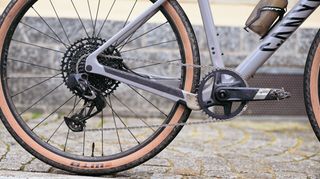
All bikes with the exception of penny-farthings are geared between the crankset and the rear wheel. Most bikes will include a range of gears, so that you can choose one appropriate to where you’re riding – a lower, easier gear for climbing a hill and a higher, harder one for riding on the flat or downhill.
So far, so simple, but things rapidly get more complicated when you consider how gears work and the different systems available. It’s even more complex when you take into account compatibility (or lack thereof) between different brands.
Gears form part of a groupset , which also includes brakes and brake levers. Brands will sell a hierarchy of groupsets, with more money in general buying you a greater number of gears, better designs and lower weight.
In this guide, we’ll go through how different gear systems work, how to operate them, as well as providing a brief overview of how to maintain your bike's gears and when parts might need replacing.
Derailleur gears

The majority of bikes use a derailleur gear system. This comprises a series of sprockets with a range of sizes attached to the rear hub, which form a cluster called a cassette. In modern systems, the freewheel system is built into the wheel but in lower spec or older bikes it forms part of the gear cluster.
The bike’s chain runs through a rear derailleur which hangs below the rear axle and moves laterally across the cassette in response to the rider’s input. As the derailleur pushes the chain to the side, this derails from its current sprocket and skips to a larger or smaller one.
The derailleur has a sprung mechanism which holds of a pair of jockey wheels and keeps the chain taut regardless of which sprocket has been chosen. The sprockets are typically engineered with small ramps and clever tooth profiles that promote fast, smooth shifting.
Get The Leadout Newsletter
The latest race content, interviews, features, reviews and expert buying guides, direct to your inbox!
Changing between sprockets changes the gear ratio, the number of turns that the rear wheel makes for every turn of the cranks. Shifting to a larger sprocket makes riding easier, while shifting to a smaller sprocket makes it harder.
The cassette may include anything between seven and 13 sprockets, depending on the groupset model.
In addition to the rear derailleur, many bikes have a front derailleur and include two or three different size chainrings, although single chainring set-ups (often called one-by or 1x) are common on mountain bikes. They’re also found on many commuter bikes and gravel bikes and occasionally on road bikes.
Although the chain is not permanently engaged with the front derailleur, this works in a similar fashion to the rear derailleur, pushing the chain between chainrings when the rider initiates a front gear change.
What does 'speeds' mean?
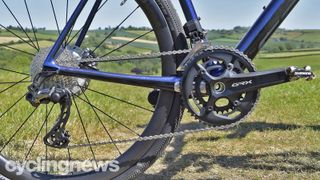
You’ll often see ‘speeds’ mentioned when reading about bike groupsets. This refers to the number of sprockets in the cassette, meaning an 11-speed groupset will have 11 sprockets. However, the actual number of discrete gears available in groupsets with two chainrings a the front is double this, while it’s three times the number of speeds with a triple chainset.
In reality, there’s usually significant overlap between gear ratios when using the different chainrings, so the number of actually-useful different gear ratios will be lower than this.
Extreme cross-chaining between the largest chainring and largest sprocket or smallest chainring and smallest sprocket may not be efficient and may result in more rapid chain wear and so should be avoided, further reducing the number of gear combinations available.
Single-speed gearing
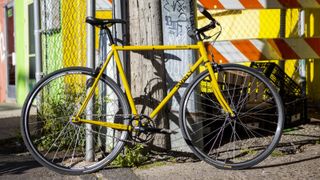
Not all bikes have multiple gear ratios; some have single-speed gears , where the chain connects a single chainring to a single sprocket at the rear.
In some cases, the sprocket may incorporate a freewheel mechanism, letting you stop pedalling while the bike still rolls forward, while in others it’s fixed rigidly to the rear wheel, so that when the bike is moving you have to keep pedalling.
Single-speed gearing with a freewheel is often found on children’s bikes and popular on town bikes. Track bikes meanwhile have fixed gearing, as do some ‘fixie’ hybrid bikes for urban use.
A variant on chain-driven single-speed gearing is a belt drive, of which the Gates Carbon Drive is the most commonly used. This uses a toothed carbon fibre belt to transfer power to the rear wheel and has the advantage of being virtually maintenance-free and silent, although it can’t work with a derailleur gear system.
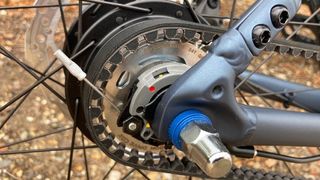
A single-speed external drivetrain may be paired with a hub gear system. Here, the bike’s gears are fully enclosed within the rear hub and may offer anything between two and 14 gear ratios. Hub gears have the benefit of low maintenance and protection from bashes and damage, but are in general heavier than equivalent derailleur systems.
Hub gears use planetary gear systems, like those used in many cars with automatic gearboxes. The gears inside the hub are permanently engaged, so you can shift when stationary, unlike a derailleur system. While most hub gears provide discrete ratios, some gear hubs offer continuously variable gearing with no steps between gears, such as Enviolo and Pinion.
Gear selection
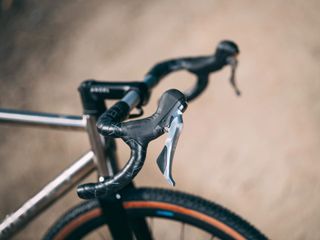
In the vast majority of systems, the rider selects their gear using levers mounted on the handlebars, although in the past road bike gear shifters were fixed to the bike’s down tube. Interestingly, for electric city and e-mountain bike use, Shimano makes an automatic gear system, which will select the gear for you without intervention.
Flat bar bike gear shifters are separate from the brake levers, although usually mounted close to them. Some flat bar bikes incorporate the shifting mechanism into the bike’s hand grips, with shifting initiated by twisting the grip.
In contrast, drop bar bike gear shifters are usually incorporated into the brake levers to make them easier to use. You can also find bar-end gear shifters for drop bars, although these are a niche item.
Most gear systems now incorporate indexed shifting, which means that the shifters operate in discrete clunks when you shift, allowing precise movement between gears. In contrast, old school down tube shifters were continuously variable, so you had to fine-tune the derailleur position once you’d shifted.
Mechanical and electronic shifting
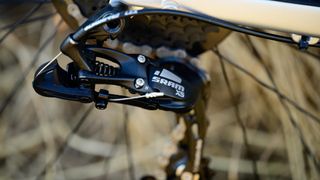
In the vast majority of gear systems, a braided wire cable, running through or outside the bike’s frame tubing, physically connects the bike’s shifters to the shifting mechanism. The cable is enclosed within an outer cable housing, which may enclose the full length of the gear cable, although on some bikes the cabling may include sections that are partly bare.
Mechanical shifting systems are simple, although they can be prone to contamination, fraying or breakage and need to be kept clean and lubricated to work efficiently. Cables also stretch, so periodic adjustment may be necessary.
A more recent development for high-end groupsets is the move to electronic shifting. Here, the signal is transmitted from the shifter to the derailleur electronically. In Shimano and some other systems , a central battery within the bike’s frame powers a motor in each derailleur to shift gears. SRAM and the latest Campagnolo electronic shifting systems, in contrast, have a small proprietary battery attached to each derailleur.
The first electronic shift systems from Shimano and Campagnolo had physical electric wires connecting the shifters on the handlebars to the derailleurs (and in the case of Shimano, its electronic hub gears were wired as well), but the most recent systems use wireless signal transmission. Coin cell batteries in the shifters power their electronics. SRAM electronic systems have always used wireless signalling.
Initially the preserve of the most expensive groupsets, electronic shifting is progressively trickling down to lower priced ones. It’s still expensive, but becoming less so.
What are the advantages of electronic systems?

While mechanical systems limit shifting logic to moving up or down the gear range, electronic shifting opens up additional possibilities. For example, a rider can set up sequential shifting, where, in a double chainring system, they only have to choose to shift up or down gears, with the groupset itself initiating a front chainring shift when needed to prevent cross-chaining.
It’s also possible to set up the derailleurs so that the rear derailleur shifts a couple of sprockets up or down the cassette automatically when the rider chooses to change chainrings. This avoids the tendency for the rider to find themselves either spinning too quickly or grinding too slowly after a front shift.
Electronic systems can even transmit gear information to a cycling computer and you can set up small satellite shifters so that, on a drop bar bike, you can shift from the drops or the tops, as well as the shift levers. They can be adjusted with the help of a smartphone app, and provide gear use statistics too. They can even be completely reprogrammed if you want each button to work differently.
The downside of electronic shifting is the need to ensure that batteries are kept topped up, although they need recharging fairly infrequently. If they do go flat during a ride, they are designed to reduce available gear changes gracefully, so that you’d be unlucky to be left with a single-speed bike.
Bike gear maintenance

Bike gears are, to a greater or lesser extent, exposed to the elements, even in single-speed systems. The sprockets, derailleurs and chain get dirty and chains are prone to rust when they get damp.
It’s important to keep gear systems lubricated using an appropriate bike chain lube , and to clean your chain periodically to keep everything working effectively. In a mechanical system, also keep the cables lubricated and replace them if there are signs of fraying.
Cables are particularly prone to damage inside the shift levers, where they are forced to wind through tight angles.
When should I replace my bike gears?
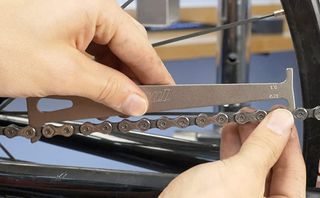
The first part to wear out is usually the chain, which will stretch with use. You can buy a chain wear checker or get a shop to check it. Chains typically need replacing when they reach 0.75% of stretch, as shown on the chain checker tool.
Chain wear can lead to poor shifting, which isn’t crisp. It also wears your rear sprockets and, at a slower rate, the teeth in your chainrings. It’s usual to replace your cassette at the same time as your chain to restore smooth shifting.
You may also experience poor shifting due to cable stretch and wear or contamination and need to replace these.
Derailleur mechanisms often need to be fine-tuned , either by using the derailleur’s barrel adjuster to ensure that the derailleur is correctly positioned below each sprocket, or by adjusting the derailleur limit screws if the chain is failing to engage with the smallest or largest sprocket, or falling off either end of the cassette.
Yet another cause of poor shifting is derailleur hanger mis-alignment, which usually needs to be sorted by a shop, which will have the tools needed.
Replacing your gear components

Unless you replace like with like, any gear system component replacement quickly runs into compatibility issues.
First up, the speeds need to match: you can’t use an 11-speed cassette with a ten speed system, for example. You can usually swap out items between different levels in a groupset hierarchy though, if they have the same number of speeds. Such as SRAM Force and Red, or Shimano 105 and Ultegra.
Derailleurs also have a maximum range, so you can’t, for example, fit an 11-42 tooth cassette to a double chainring system, only one designed specifically for single chainrings. Much road bike gearing is incompatible with mountain bike components and vice versa.
With mechanical systems, there’s limited compatibility across groupset brands too. SRAM shifters won’t work with Shimano derailleurs for example, although you can use either brand’s cassette and chain or third party equivalents if they have 11 speeds or fewer.
And finally, top end electronic systems are even less compatible across brands. Again, there’s usually the option to swap within a groupset hierarchy should you wish. So, for example, you could use a SRAM Rival 12-speed cassette in your SRAM Red system or a 12-speed Ultegra component with 12-speed Dura-Ace.
Hopefully that's helped to answer your questions and gear queries, but drop us a comment below if you're still unsure. Otherwise, get out there and put your newfound knowledge to good use.

Thank you for reading 5 articles in the past 30 days*
Join now for unlimited access
Enjoy your first month for just £1 / $1 / €1
*Read any 5 articles for free in each 30-day period, this automatically resets
After your trial you will be billed £4.99 $7.99 €5.99 per month, cancel anytime. Or sign up for one year for just £49 $79 €59

Try your first month for just £1 / $1 / €1
Paul has been on two wheels since he was in his teens and he's spent much of the time since writing about bikes and the associated tech. He's a road cyclist at heart but his adventurous curiosity means Paul has been riding gravel since well before it was cool, adapting his cyclo-cross bike to ride all-day off-road epics and putting road kit to the ultimate test along the way. Paul has contributed to Cyclingnews' tech coverage for a few years, helping to maintain the freshness of our buying guides and deals content, as well as writing a number of our voucher code pages.
Colnago embraces normal standard and makes no aero claims with its new G4-X gravel race bike
Amer Sports sells off Enve
'It was not the main goal' - Marianne Vos takes red leader's jersey at La Vuelta Femenina
Most Popular

- Mountain Bikes
- Gravel Bikes
- Hybrid Bikes
- Electric Bikes
- Commuter Bikes
- Exercise Bikes
- Women’s Bikes
- Kids’ Bikes
- All Best Bike Brands
- Mountain Bike Brands
- Electric Bike Brands
- Bike Rack Brands
- Brand Review: Rad Power Bikes
- Brand Review: Ride1UP Bikes
Disclaimer: Bikexchange is reader-supported . We may earn an affiliate commission when you buy through the links on our site.
Trek Verve Disc Series Review
Trek’s Verve range of hybrid bikes has received excellent reviews since its release. The majority of users say they offer excellent value for money, providing high-quality parts and materials at a low cost. For work commuters, weekend riders, or those looking to do short tours with light loads, you’ll struggle to find better-priced bikes of the same quality.
Who Is The Trek Verve For?
Trek’s new range of Verve hybrid bikes is aimed at urban commuters and recreational riders looking to do short trips around town. They have comfortable seating positions, straight handlebars, and frame mounts for fitting pannier racks and fenders. All bikes in the Verve range come in both standard and “low-step” models for cyclists who require easier mounting.
Best for: Urban commuting Top features : Bontrager components, Alpha Gold aluminum frame, DuoTrap S compatibility, Rack/fender ready, Mechanical/Hydraulic Disc Brakes
Trek Verve Disc Top Features
Verve 1 '2020 verve 2 '2020 verve 3 '2020 weight l - 13.73 kg / 30.26 lbs l - 13.20 kg / 29.1 lbs l - 13.73 kg / 30.26 lbs tires bontrager h5, wire bead, 30 tpi, 700x45c bontrager h5, wire bead, 30 tpi, 700x45c bontrager h5 hard-case ultimate, wire bead, 60 tpi, 700x45c stem bontrager quill, 25.4mm clamp, 25 degree bontrager alloy quill, 31.8mm clamp, adjustable rise, blendr compatible bontrager alloy quill, 31.8mm clamp, adjustable rise, blendr compatible, (s,m 85mm / l,xl 105mm length) shifters shimano altus ef500, 7 speed shimano altus m310, 8 speed shimano acera m3000, 9 speed / sl-m3010, 2 speed seatpost bontrager alloy, 27.2mm, 12mm offset alloy, adjustable suspension, 27.2mm alloy, adjustable suspension, 27.2mm, 300mm length saddle bontrager boulevard bontrager boulevard bontrager boulevard rims bontrager connection, alloy, double-wall, 32-hole, schrader valve bontrager connection, alloy, double-wall, 32-hole, schrader valve bontrager tubeless ready disc, 32-hole, presta valve rear hub formula dc31 alloy, 135x5mm qr formula dc22 alloy, 135x5mm qr formula dc-22, alloy, 6-bolt, shimano 8/9/10 freehub, 135x5mm qr rear derailleur shimano altus m310 shimano altus m310 shimano acera m3000, shadow design, long cage pedals wellgo nylon platform bontrager satellite city pedal bontrager satellite city pedal headset 1-1/8" threadless, semi-integrated, semi-cartridge bearings 1-1/8" threadless, semi-integrated, semi-cartridge bearings 1-1/8'' threadless, semi-integrated, semi-cartridge bearings handlebar trek urban alloy, comfort sweep, 25.4mm, 45mm rise bontrager alloy, 31.8mm, comfort sweep bontrager isozone alloy, 31.8mm, comfort sweep (s,m - 620mm l,xl - 665mm width) grips bontrager satellite bontrager satellite bontrager satellite isozone plus, lock-on, ergonomic front hub formula dc-20, alloy, 6-bolt, 5x100mm qr formula dc-20, alloy, 6-bolt, 5x100mm qr formula dc-20, alloy, 6-bolt, 5x100mm qr front derailleur shimano tourney ty510, 34.9mm clamp, top swing, dual pull shimano tourney ty710, 34.9mm clamp, top swing, dual pull shimano acera t3000, 34.9mm clamp, top swing, dual pull frame alpha gold aluminum, duotrap s compatible, disc brake, rack & fender mounts, 135x5mm qr alpha gold aluminum, duotrap s compatible, disc brake, rack & fender mounts, 135x5mm qr alpha gold aluminum, duotrap s compatible, disc brake, rack & fender mounts, 135x5mm qr fork steel, disc, rack mounts, 415mm axle-to-crown, thruskew 5mm qr alloy, disc, rack mounts, 415mm axle-to-crown, thruskew 5mm qr alloy, disc, rack mounts, 415mm axle-to-crown, thruskew 5mm qr crank forged alloy, 48/38/28, chainguard forged alloy, 48/38/28, chainguard shimano mt210, 46/30, chainguard (s,m 170mm / l /xl 175mm) chain kmc z51 kmc z7 kmc x9 cassette sunrace mfm300 freewheel, 14-34, 7 speed shimano hg31, 11-32, 8 speed shimano hg200, 11-36, 9 speed brakeset tektro md-m280 mechanical disc, 160mm rotor tektro hd-m275 hydraulic disc, 160mm rotor shimano mt200 hydraulic disc, shimano rt26, 160mm, 6-bolt bottom bracket vp bc55p, 68mm, threaded vp bc73, 68mm, threaded, shimano acera groupset.
The Verve 3’s benefits from the smooth and efficient gearing provided by Shimano’s Acera components. Both the front and back derailleurs are Acera as well as the shifters. Trek has downgraded the front crank to a 2-speed ring but put a 9-speed Shimano HG200 cassette on the rear, with 11-36 cogs. This gives the rider 18 gears overall with the added range provided by the extra-large 36t rear cog.
Hydraulic Disc Brakes
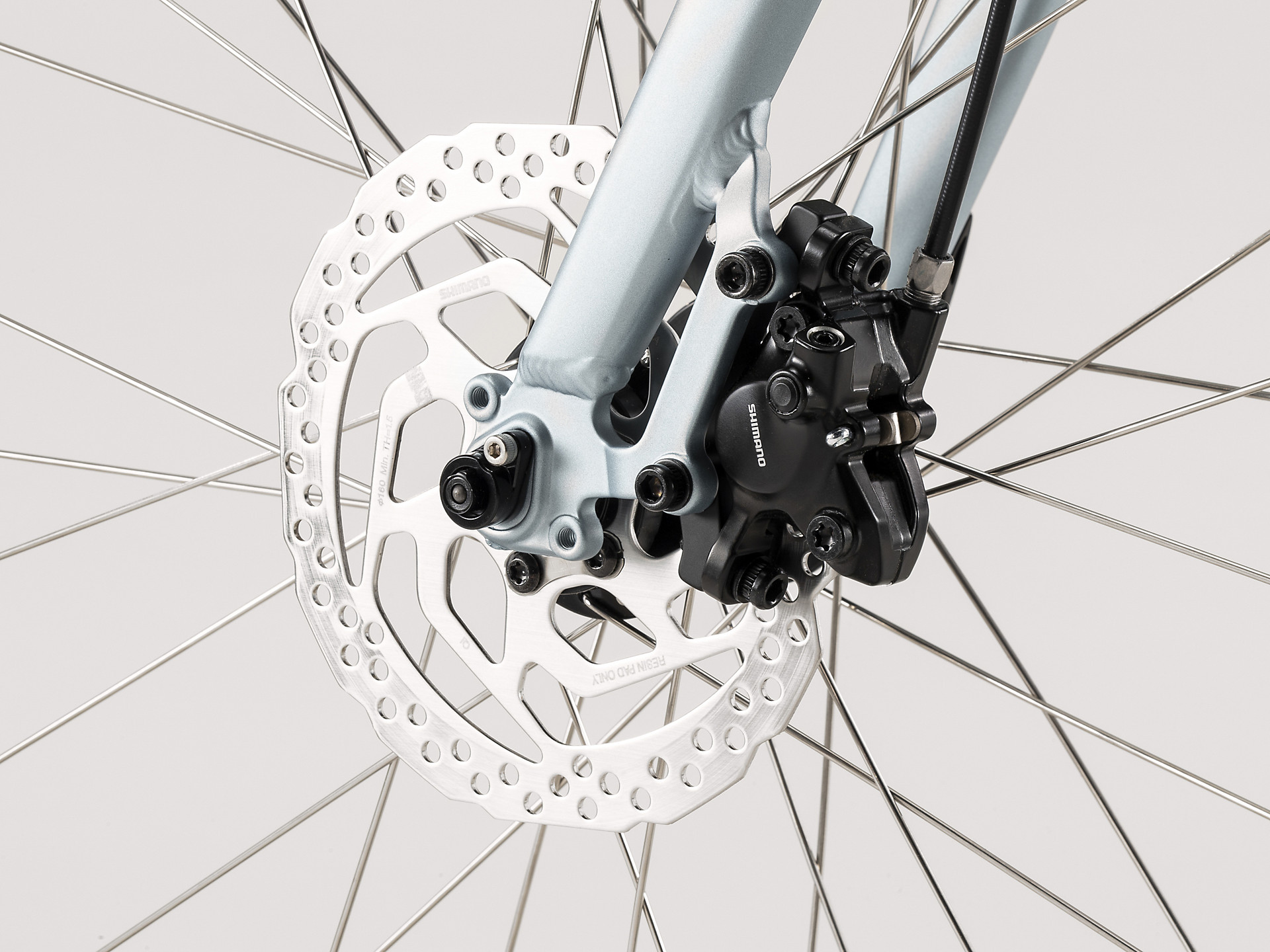
Trek has also decided to go with Shimano in the braking department this time around. Shimano’s MT200 hydraulic disc brakes are a firm favorite amongst hybrid and MTB riders alike. They provide great grip, instant reaction time, and no slippage even in wet weather.
Bontrager Hardcase Wheels
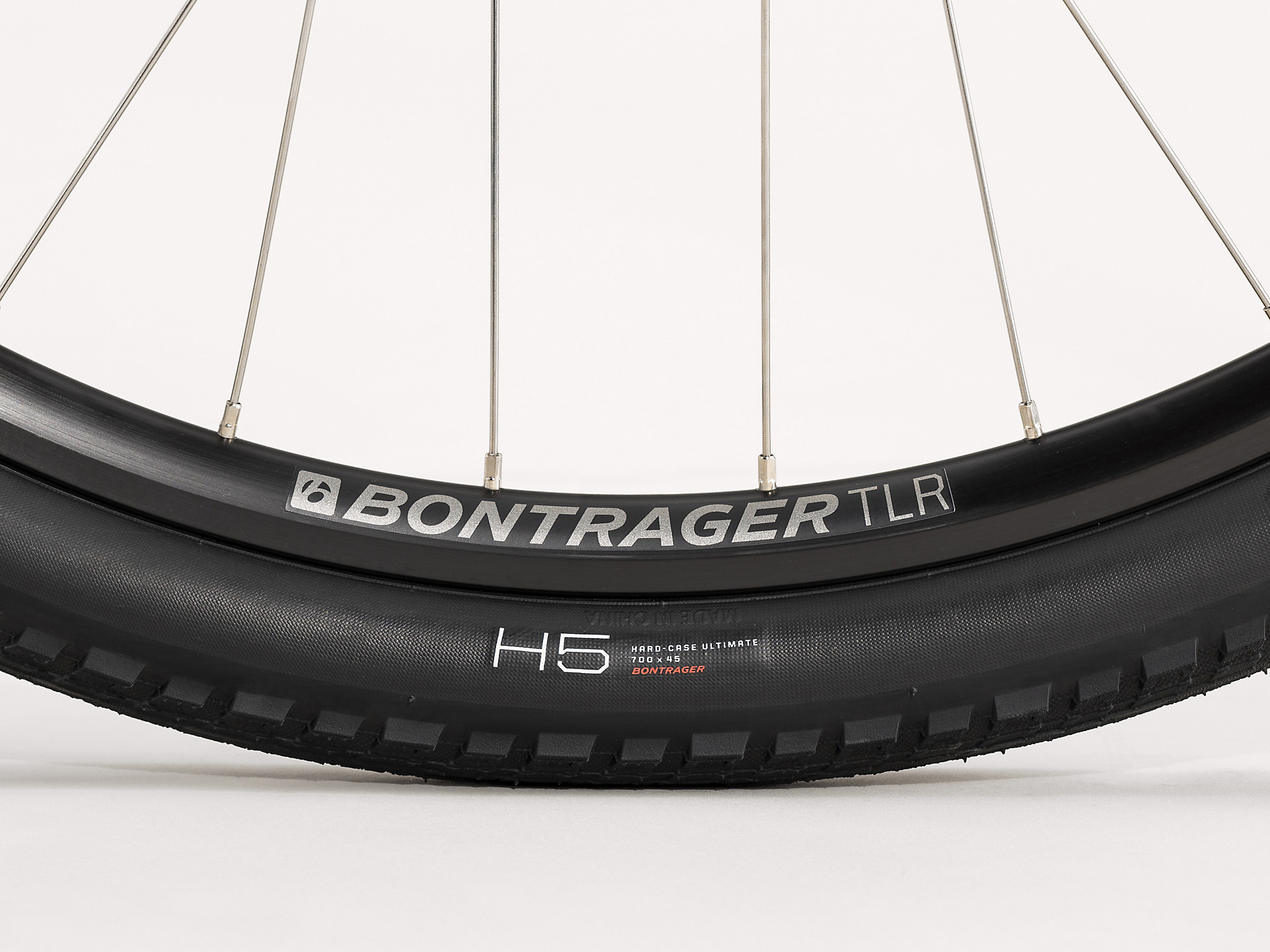
Bontrager’s Hardcase Ultimate tires are the real deal when it comes to tackling hazardous city streets. These things will carve through rubble or broken rocks without trouble and should even keep you safe against glass shards or small nails. The 700c x 45 wire-beaded tires also have reflective sidewalls for safer night riding.
Alpha Gold Aluminum Frame
The Alpha Gold aluminum frame is compatible with Trek’s DuoTrap S sensor system for tracking your progress. It also has a front and rear rack and fender mounts if you wish to convert the Verve 3 into a decent touring bicycle. With the strong frame and alloy fork, the Verve 3 can carry up to 300 lbs (136 kg) of overall weight (rider and luggage).
DuoTrap S Compatible
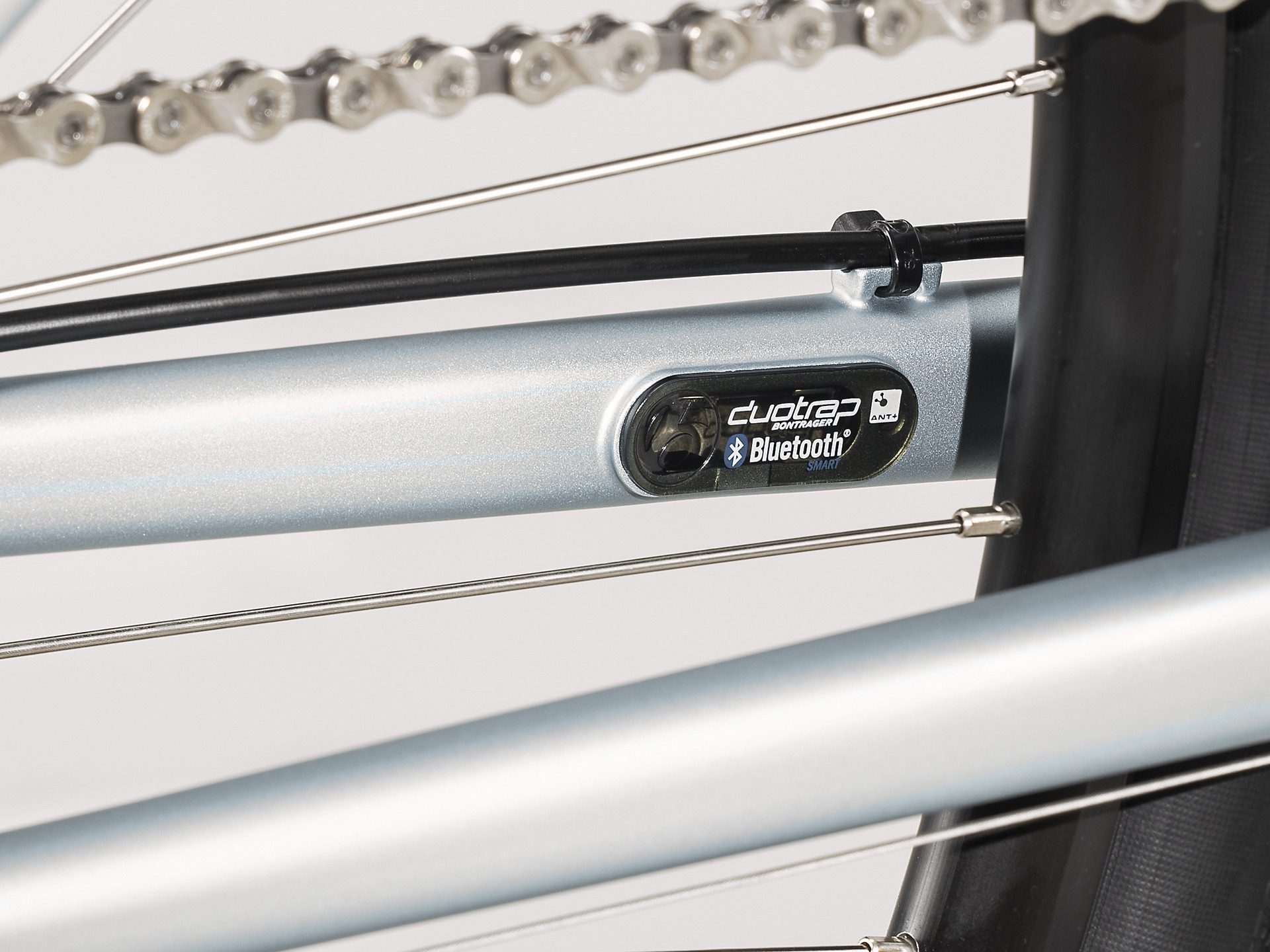
DuoTrap S is Trek’s unique frame-integrated wireless computer system that tracks your statistics while you cycle. It can be installed neatly into the frame on the inside of the rear wheel for a clean and aerodynamic finish. The DuoTrap S device (sold separately) tracks your cycling statistics and sends the information wirelessly to a Bluetooth or ANT+ enabled cycling computer or smartphone.
Trek Verve 1 Disc

MSRP $530 Best Features : Mechanical disc brakes, Bontrager Tires, DuoTrap S compatible (Not included)
Verve 1 is an excellent introductory hybrid bike at an attractive price . Its comfortable geometry is perfect for first-timers or casual recreational riders. It’s built from tough, reliable components that are simple to clean and repair, making maintenance an easy task for new riders. It doesn’t have the suspension required for heavy off-road riding but it does have extra-large tires to absorb the shock of small rocks and bumpy roads. This makes it a decent bike for riding on dirt tracks in parks or along country lanes.
- Men’s Trek Verve 1 Disc comes in two colors: Factory Orange and Trek Black , and four sizes: S, M, L, XL.
- Women’s Trek Verve 2 Disc comes in four sizes: XS, S, M, L and in two colors: Era White , and Dnister Black
Main Features
Aluminum frame and steel fork.
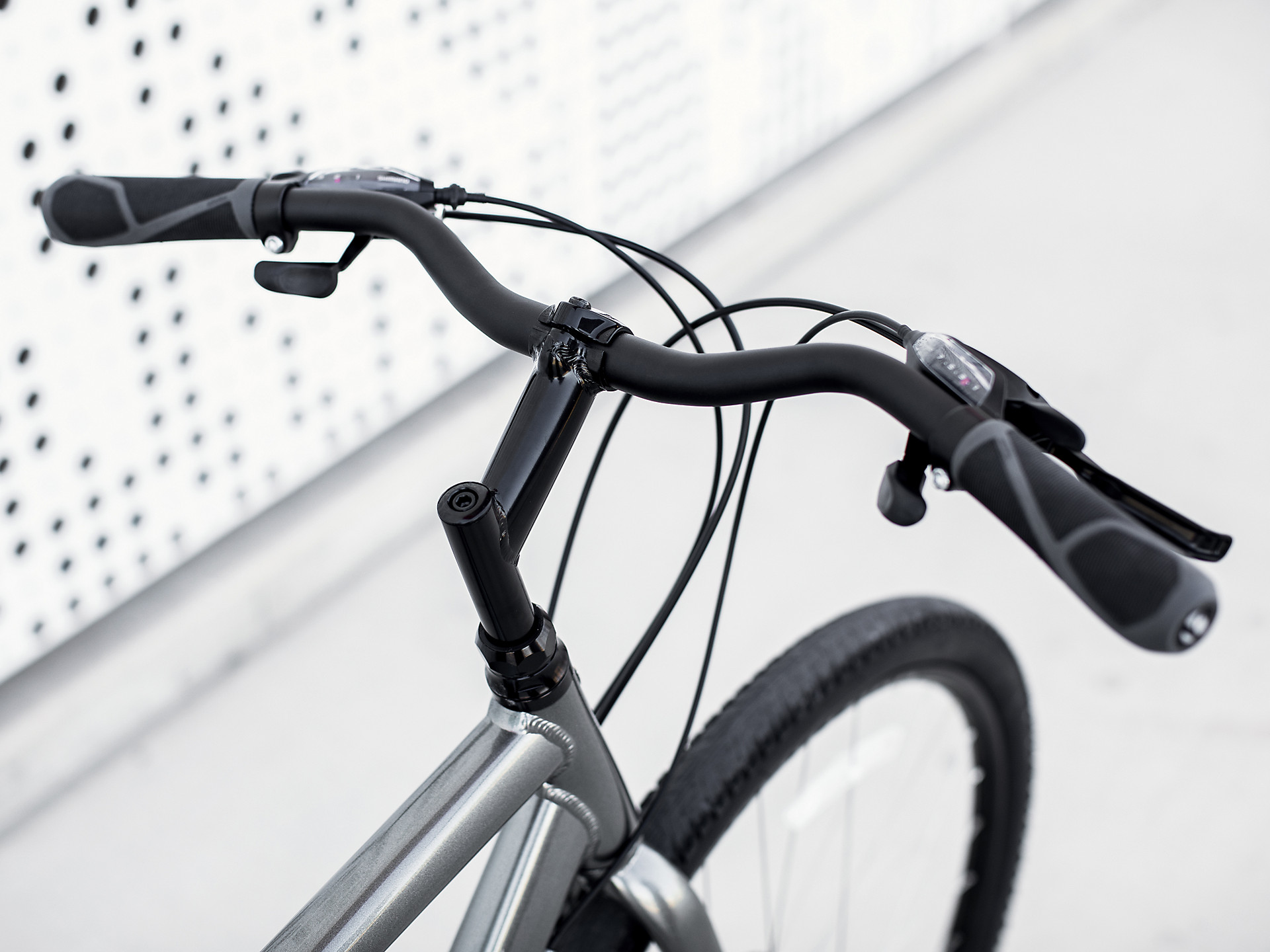
The strong Alpha Gold aluminum frame is built to carry weight and take abuse so it won’t break on you anytime soon. Attach a rack to the rear so you can carry groceries or go on short weekend camping trips in the countryside. This is complemented by a steel front fork with rack and fender mounts.
Mechanical disc brakes
Disc brakes provide much-improved stopping power in wet weather so you won’t have to worry about cycling in the rain. These Tektro MD-M280 mechanical disc brakes are highly rated and quality tested.
Shimano Gearing
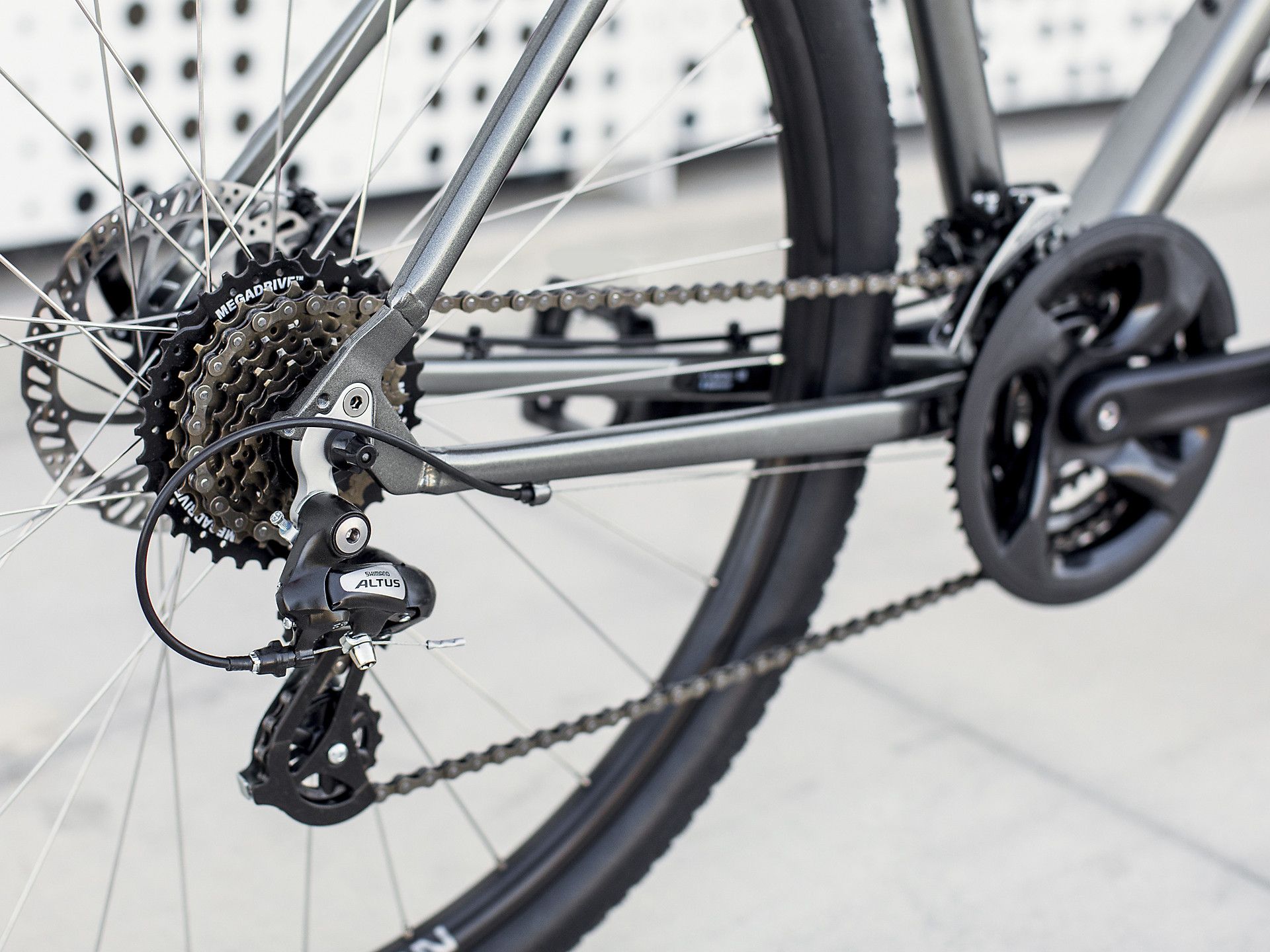
The Verve 1 has good value Shimano Altus and Tourney derailleurs making up its 21-speed drivetrain, with a SunRace 14-34t freewheel cassette. The combination offers a wide range of gears so you can tackle any hills without trouble.
Extra-large tires
Bontrager supplies the extra-large 700x45c tires on the Verve 1 so you can comfortably attack even the most cobbled streets. The thick wire-bead tires offer maximum puncture protection and have reflective sidewalls for safer night riding.
The Verve 1 is compatible with Trek’s proprietary DuoTrap S wireless computer system (sold separately). The system tracks your cycling statistics and sends the information wirelessly to a Bluetooth or ANT+ enabled cycling computer or smartphone.
Trek Verve 2 Disc

MSRP $670 Best Features : Hydraulic Disc Brakes, Bontrager 700x45c wheels, Alpha Gold aluminum frame, Suspension seat post
The Verve 2 is an intermediate hybrid bike for casual riders with some nice components upgrades from Verve 1. Most notably, the Verve 2 is fitted with a higher-quality Shimano 8-speed cassette that offers a wider range of gears. It benefits from the same solid aluminum frame material but with a lighter alloy fork at the front.
- Men’s Trek Verve 2 Disc comes in four sizes (S, M, L, XL) and two colors: Rage Red and Lithium Grey. Coming in at about 29 lbs (13.2 kg), it’s a bit lighter than the Verve 1 but equally strong and reliable.
- Women’s Trek Verve 2 Disc comes also in four sizes (XS, S, M, L) and two colors: Teal and Quiksilver. Weighing 28.8lbs (13kg).
Shimano Groupset
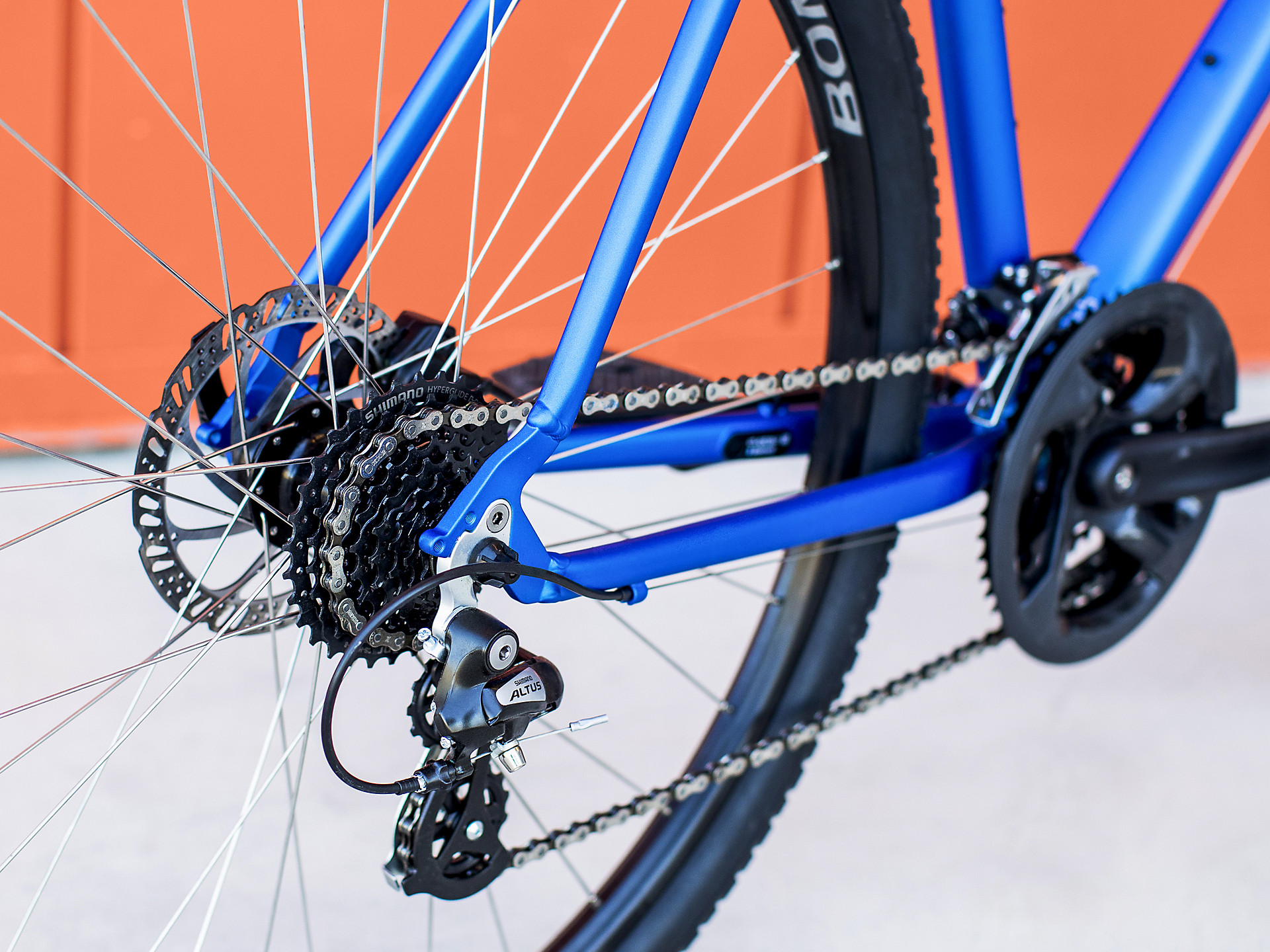
The Verve 2 has a full Shimano drivetrain comprised of Altus and Tourney derailleurs and an 8-speed Shimano HG31 cassette. Combined with the triple cog on the crank gives you 24 gears in total, enough to tackle steep hills or hit the tarmac with speed.
Hydraulic disc brakes
The Verve 2 enjoys improved braking power with Tektro HD-M275 hydraulic disc brakes. Hydraulic brakes provide quicker and more reactive braking power with less pressure required, ensuring you always stop in time and avoid accidents.
Suspension Seatpost
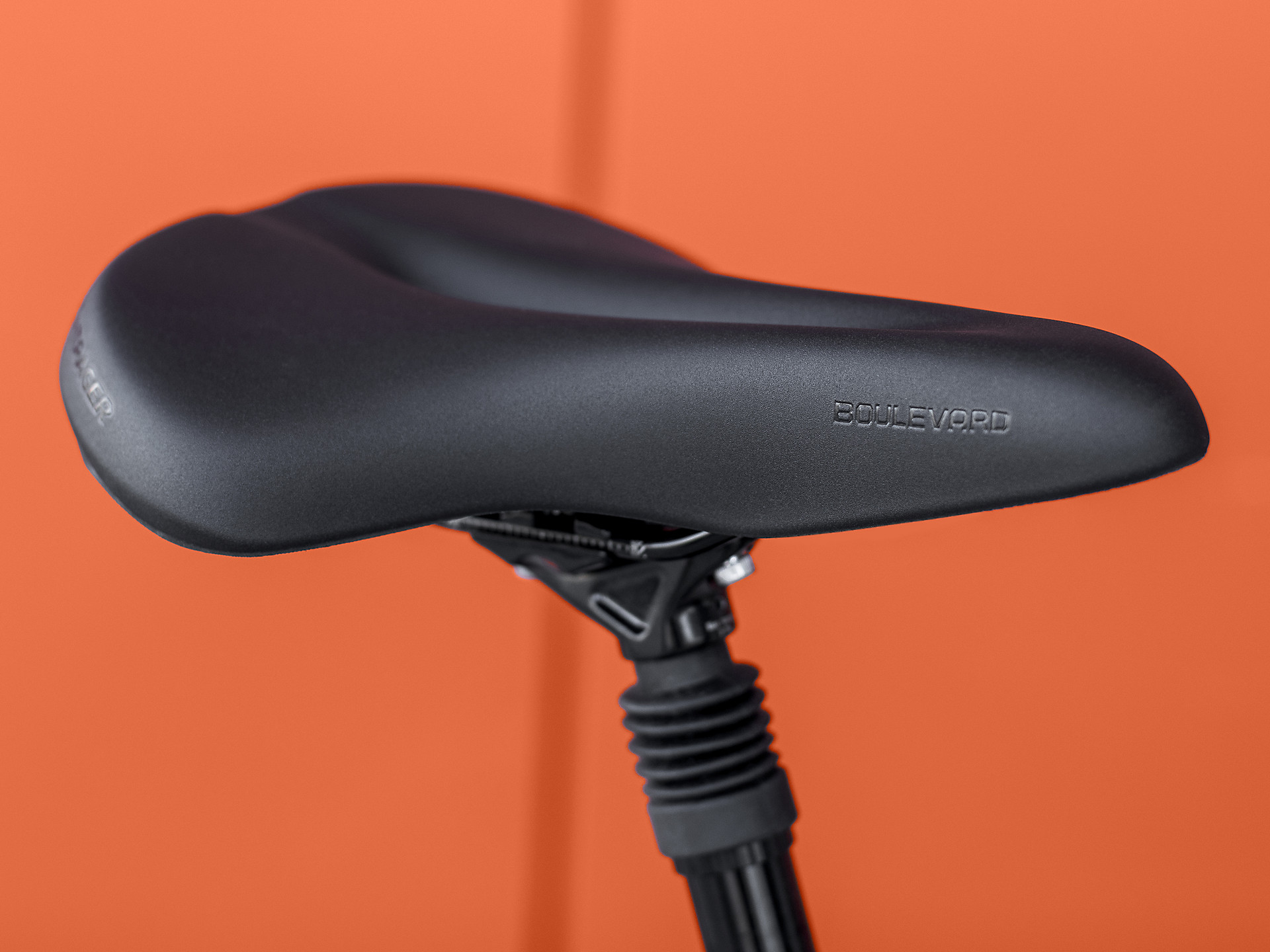
While Verve 2 doesn’t have any suspension on the front or rear wheels it does get a nice touch with seat post suspension. The alloy adjustable seat post has a small added spring that gives up to 27.2mm of travel that will absorb any sudden bumps that creep up on you.
Aluminum Frame and Alloy Fork
The Verve 2 has the same Trek Alpha Gold aluminum frame as the Verve 1 with a lighter 415mm alloy fork. The comfortable frame geometry puts the rider in an upright position, with a 71.5-degree head angle and an average 70-degree seat tube angle.
Bontrager Wheels
The wheels on the Verve 2 are Bontrager Connection with size 700x45c Bontrager H5 wire-bead tires. The thick-treaded, reflective and puncture-protected tires are strong and resilient in all types of weather, ensuring you stay safe and visible even in low-light conditions.

Trek Verve 3 Disc

MSRP $820 Best Features : Shimano MT200 hydraulic disc brakes, Bontrager Hardcase wheels, hydraulic disc brakes, Shimano Acera Groupset
The Verve 3 is Trek’s top-dog in this range of hybrid bikes and ensures you get all the best quality parts for an excellent price. The inclusion of a full Shimano Acera groupset really gives the Verve 3 an extra touch of class .
- Men’s Verve 3 Disc comes in four sizes (S, M, L, XL) and two colors: Metallic Gunmetal and Mulsanne Blue. It weighs on average 30.2 lbs (13.7 kg), making it slightly heavier than the Verve 2 and about equal to the Verve 1.
- Women’s Verve 3 Disc weighs about 13.54 kg / 29.85 lb, comes in two colors: Quicksilver, Purple Abyss. Four sizes: XS, S, M, L
What Can Be Better?
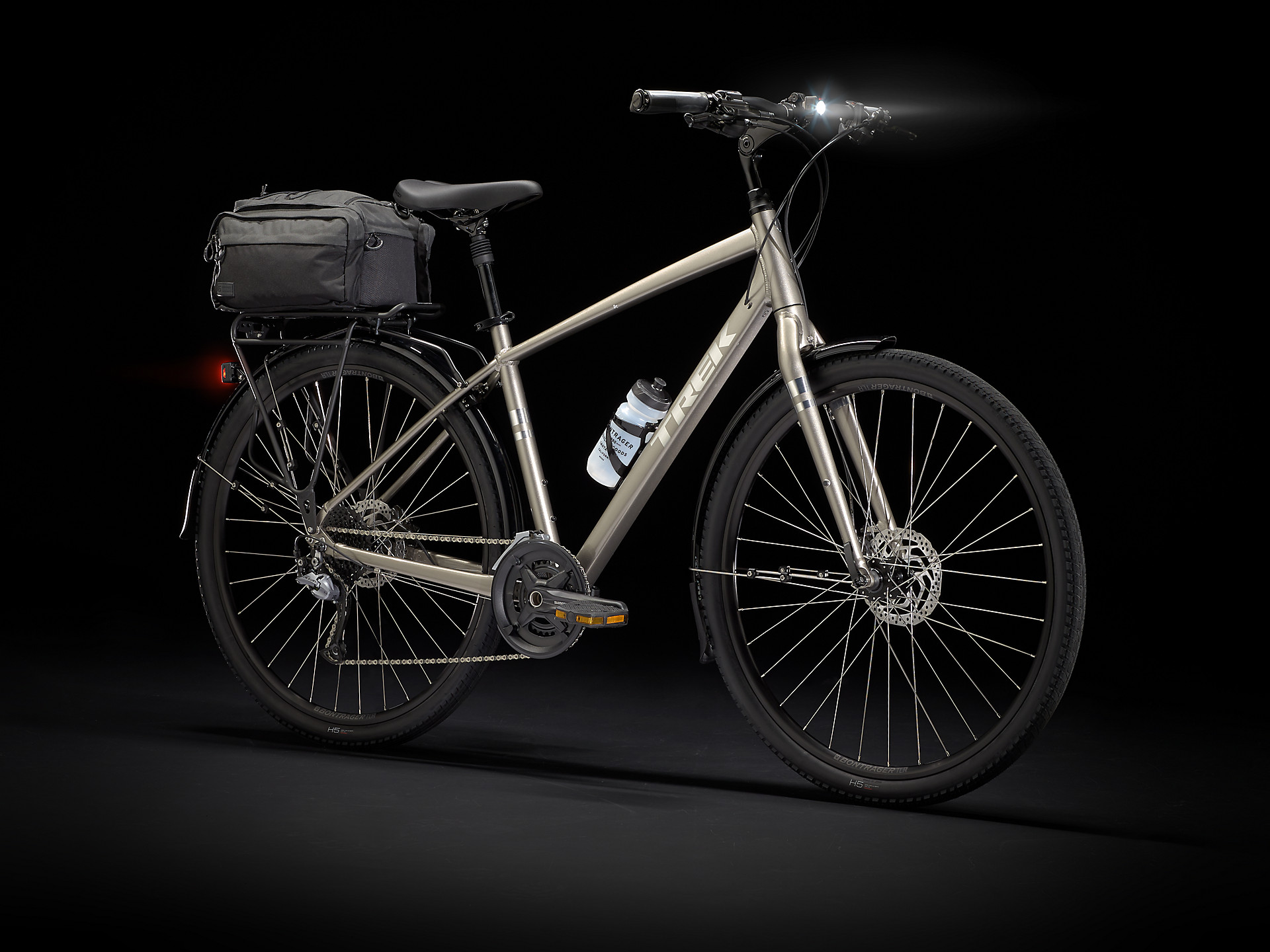
It’s hard to find any cons about those bikes, and we really couldn’t find anything major. If you are willing to sacrifice the speed and ease of riding, you might want to swap the rigid fork to a front suspension with at least 50mm travel.
Another not-so-good fact about these bikes is that they look really nice and glossy, which means you have to take good care of it by not getting the frame scratched. We also recommend investing in a solid bicycle lock too as this bike simply won’t get unnoticed!
Trek Verve Disc Sizing Chart
Conclusion: why is the verve so popular.
- Built by Trek
- Outworldly beautiful design
- Unbeatable value in terms of geometry and components
- Super comfortable and easy to ride
- Rack & fender ready for maximum versatility
Buy on TrekBikes.com
Share this on:
About the Author

Sam Millers
3 thoughts on “ trek verve disc series review ”.
It is almost impossible to fit a front rack on the verve 3. There’s only a mid fork eyelet, and the fork is too wide for the little options there are for mid-fork mounting front racks.
A friend bought a Verve 1in black. It is labeled as a “1” yet it has much up-graded components. It’s more like a “3”. It was purchased and put to together by Trek employees. Is this possible?
Hi, could you recommend a specific brand of a front suspension fork that I could buy to replace the rigid front fork for the Trek Verve 3 disc lowstep with a medium frame?
Leave a Reply Cancel reply
Your email address will not be published. Required fields are marked *

- MAGAZINE OFFERS
- BIKE INSURANCE
- Best Products
- Maintenance
- Accessories
- Long-Term Reviews
- BikeRadar Podcast
- First Look Friday
- Bike of the Week
- Tech Features
- Routes and Rides
- Bike Galleries
- BikeRadar Bargains
- Buyer's Guides
- Fitness & Training
- Sizing & Fit
- Mountain Biking UK
- Cycling Plus
The complete guide to bike gears | Bicycle transmissions explained
A beginner's guide to gears and how to use them
Russell Burton / Our Media
Benedict Pfender
All too often you will see people spinning their pedals manically or laboriously grinding their way along, barely able to move the bike. Life would be a little bit easier for these folks if they were using their gears properly.
This is the ultimate guide to what bicycle gears are and how to use the gears on your bike.
What are gears on a bike?
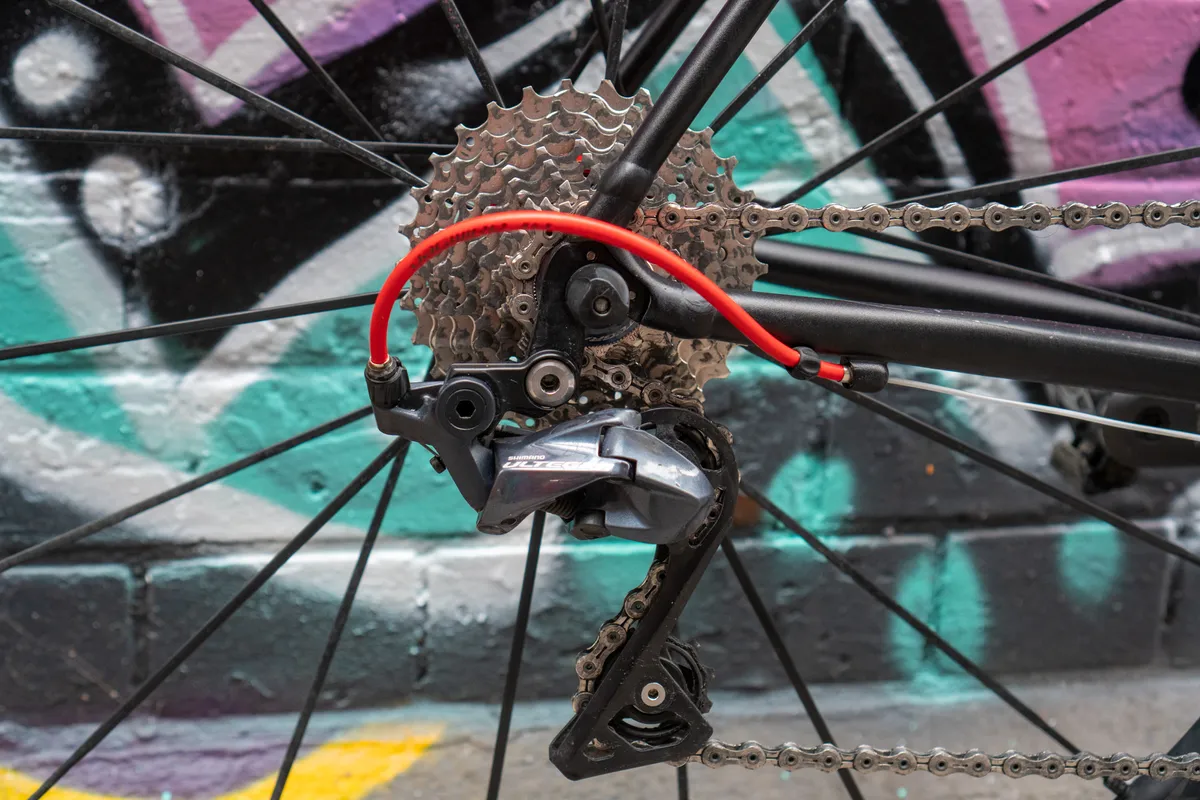
Gears are one of those lovely inventions that enable us to ride faster, climb hills more easily and get a lot more enjoyment out of our riding.
They convert the effort you put in at the pedals to a certain output at your wheel. There’s only so much force your muscles can produce and usually an optimum cadence (how fast you spin your pedals) at which you'll be most efficient.
Changing your gears based on the terrain and conditions to stay broadly in that band enables you to move forward more efficiently.
There are a few different systems that bikes use to change gears, though by far the most common are derailleur gears.
Derailleur gears explained
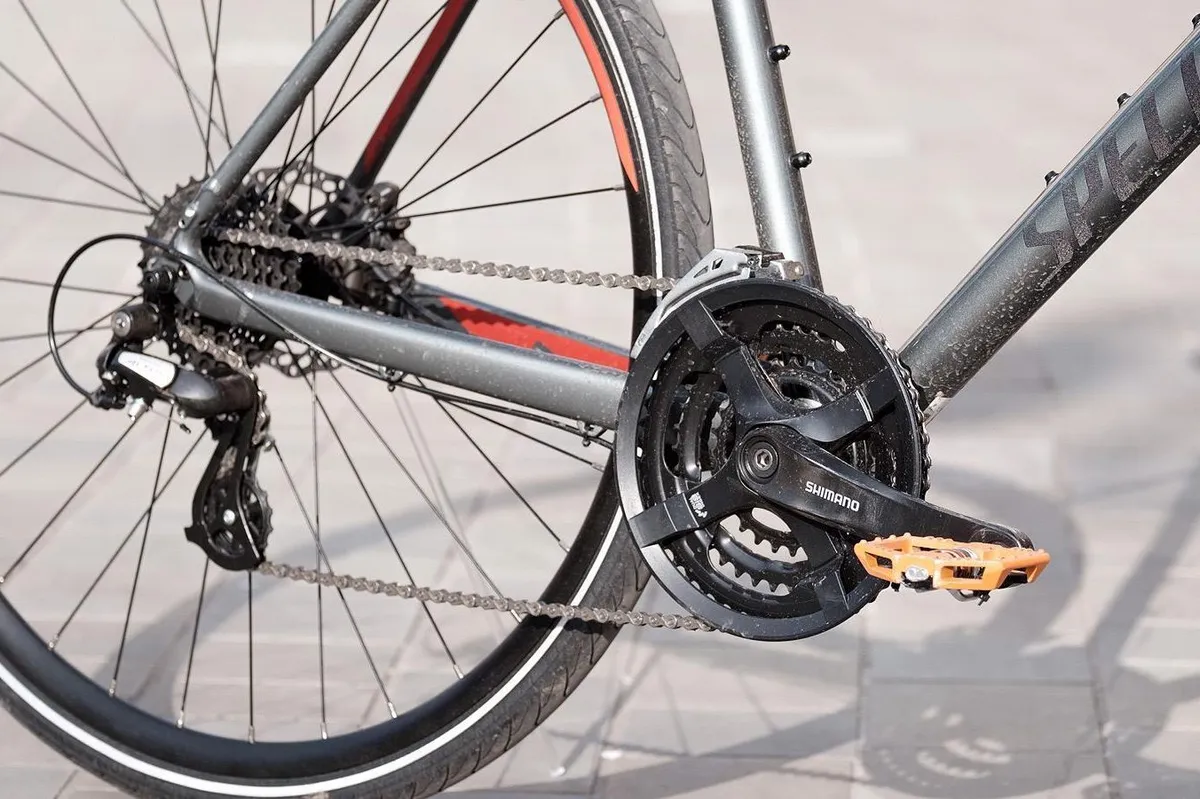
The majority of bikes on the market today sport derailleur gears, which have been refined into simple, lightweight and efficient systems.
Gears are changed on the cassette (a set of sprockets installed on the rear wheel) by the rear derailleur . This shifts the chain up or down the cassette. As the derailleur moves to change gear, it forces the chain against ramps or steps, moving it onto a bigger or smaller sprocket.
The bike may also have a front derailleur , which shifts the chain between chainrings, which are part of the crankset.
The gears at the front provide large jumps, which effectively change the range of your gears, so they are more suited to high-speed, flat-terrain or low-speed climbing. The cassette enables you to select your gear more precisely within that range as you modulate your effort.
You will usually find between one and three chainrings (single, double or triple crankset) and up to 12 sprockets (although 13 exists with Campagnolo Ekar and Rotor 1x13 ). That gives you a huge range of gears to choose from.
What is an internal gear hub on a bike?
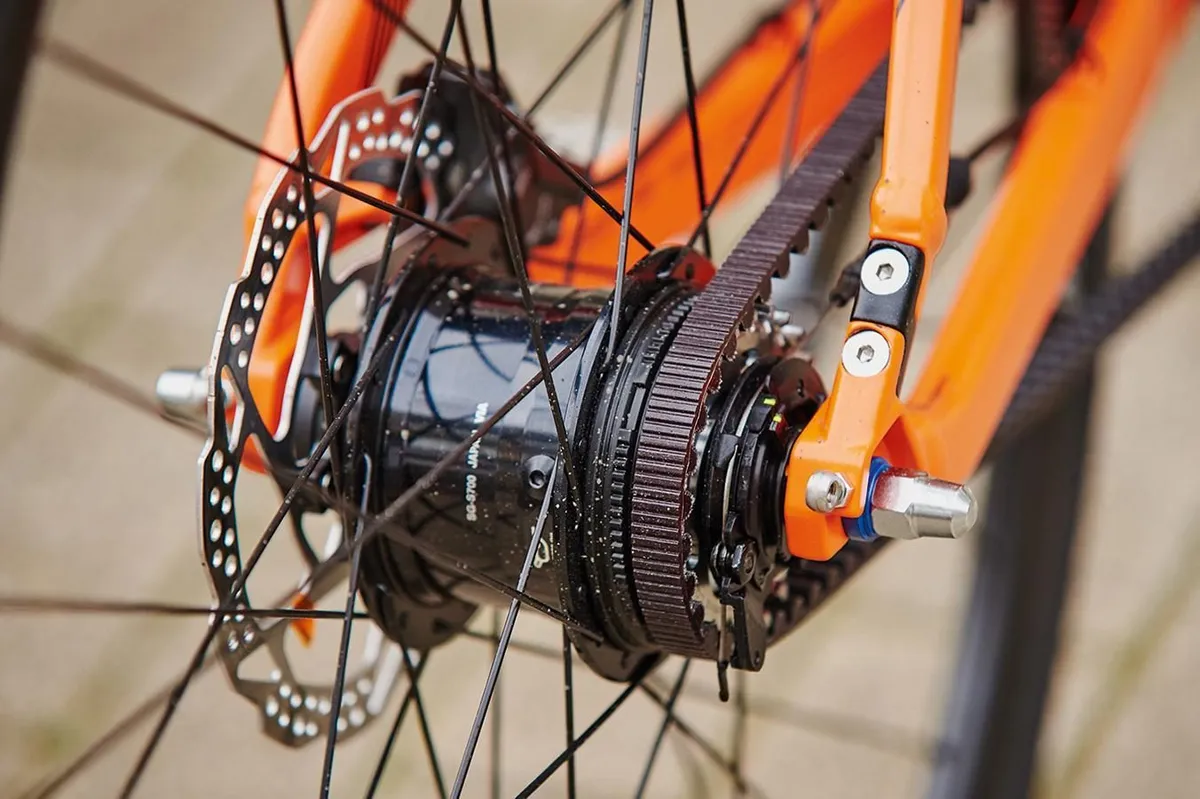
Internal gear hubs (also known as hub gears) are a popular option for commuters and those who want a robust and relatively maintenance-free drivetrain.
With service intervals ranging between 3,000 and 5,000km, internal gear hubs are great for the less maintenance-inclined.
There’s also no doubt that derailleurs are relatively exposed and susceptible to damage. Having everything nicely packaged away inside your rear wheel helps you breathe that little bit easier, especially during winter, when keeping gears protected from the elements doesn't hurt.
There are lots of hub gear options available, but the most common are from Shimano, SRAM, Sturmey-Archer and well-known manufacturer Rohloff.
With systems ranging from three to 14 gears, there's a wide range of options for whatever terrain you find yourself on.
However, the main drawback is weight. You’re riding around with a small gearbox inside your hub and that in turn contains a lot of metal parts that add substantial heft.
Fixing a puncture can also be harder with a hub gear.
Do bikes have a gearbox? What is a gearbox bike?

Part of the problem of a hub gear is that it adds weight at one end of the bike, which can lead to unbalanced handling.
Instead, a gearbox is integrated directly into the frame, with the weight positioned centrally on the bike. The cranks drive the gears directly and the output is converted in the gearbox and then transmitted to the back wheel via a chain.
One of the most exciting developments in recent times is the Pinion E-Drive Motor Gearbox unit . However, in general, gearboxes remain a niche in the bike world.

Both gearboxes and hub gears can also be used with belt drives. This requires even less maintenance than a chain because there are no links to lube, meaning they are also much cleaner than an oily chain.
However, only certain frames are compatible with a belt drive. Because the belt is a continuous loop, the frame requires removable dropouts or a chainstay splitter that enables you to thread the belt into the rear triangle.
What is an electronic groupset on a bike?
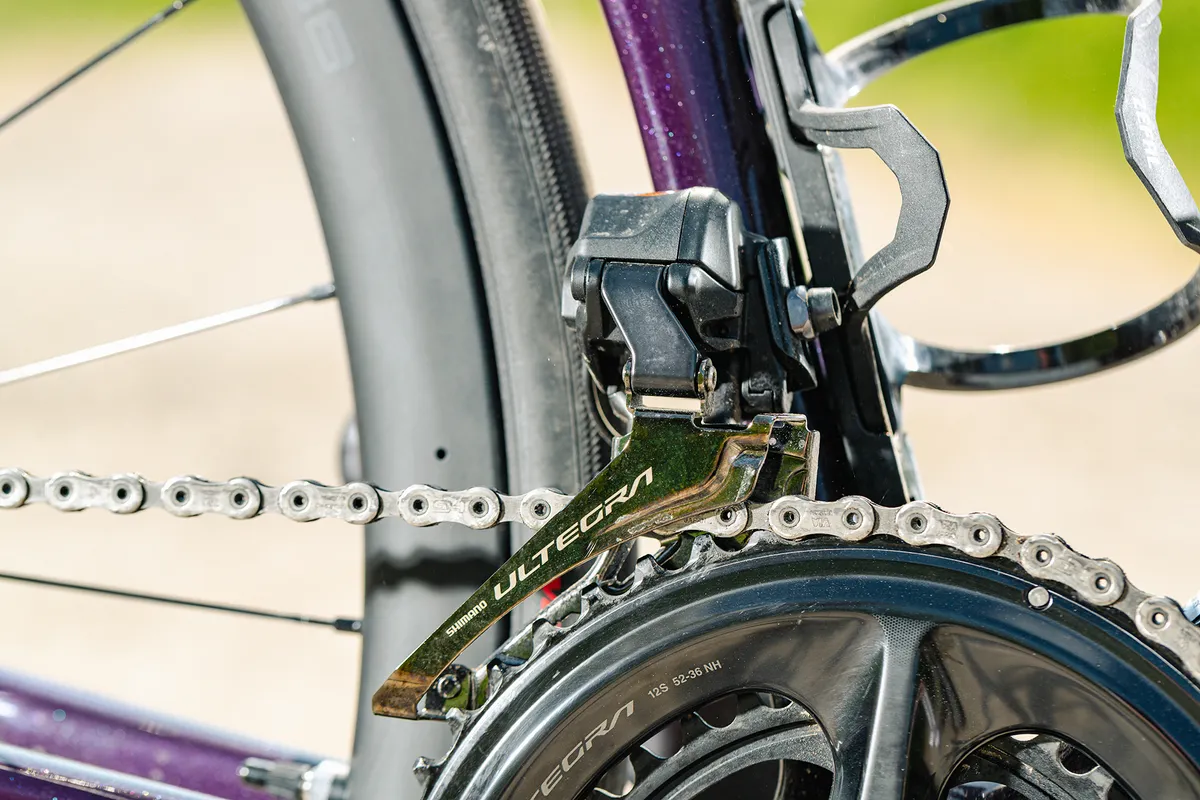
The majority of gears on bikes today are actuated by metal cables – Bowden cables to use their proper name.
However, electronic groupsets have been on the market for some time now, and are only likely to become more widespread as time goes on.
Instead of cables, the gear is shifted by an electronically controlled motor. The primary benefit is consistency. While cables can develop slop and stretch over time, an electronic drivetrain will maintain accurate shifting in all conditions.
Of course, the drawbacks are that batteries need to be charged (though not on a particularly regular basis) and the expense, although prices are slowly creeping down.

Shimano, Campagnolo and SRAM all offer electronic groupsets. Both SRAM's AXS ecosystem and Campagnolo Super Record Wireless forego wires between the derailleurs.
Shimano's Di2 ecosystem is semi-wireless – it's wireless between the shifter and derailleurs but there is a wire connecting the front and rear derailleurs to the battery.
What is a singlespeed/fixed/fixie bike?

Of course, you always have the option of just one gear, and that’s how bikes started out.
Singlespeed bikes use a single cog that can freewheel and allows the rear wheel to rotate without the pedals moving.
Fixies are even more rudimentary, with the rear cog ‘fixed’ in place, meaning if the bike is moving, the drivetrain moves, so you always have to pedal.
The main benefit is simplicity, with low maintenance requirements and cost. However, there’s no doubt singlespeeds have also become quite fashionable.
The key is to choose a gear ratio that is easy enough to get up the steepest hill you’re likely to encounter while being hard enough to avoid spinning out when things get faster.
How do I use the gears on my bike?

There’s no use having all these gears if you can’t change them. There are a number of different designs of shifter on the market, which may be operated in slightly different ways, but they're all fairly intuitive once you get to know them.
Shifters for the front and rear will be separate, located on the left and right of your bars respectively.
How to use flat-bar/mountain bike shifters
Flat bars are common on hybrid/commuting bikes, as well as mountain bikes. There are a few different shifter designs available.
How to use a trigger shifter

Nowadays, the trigger shifter is the most widespread design. It has two levers under the bar, which can be actuated with your thumbs or fingers: one to shift up and one to shift down.
Depending on the design, you may be able to change multiple gears at once or not. Shimano also has some designs that integrate the shifter and brake lever into one unit.
How to use a grip shifter
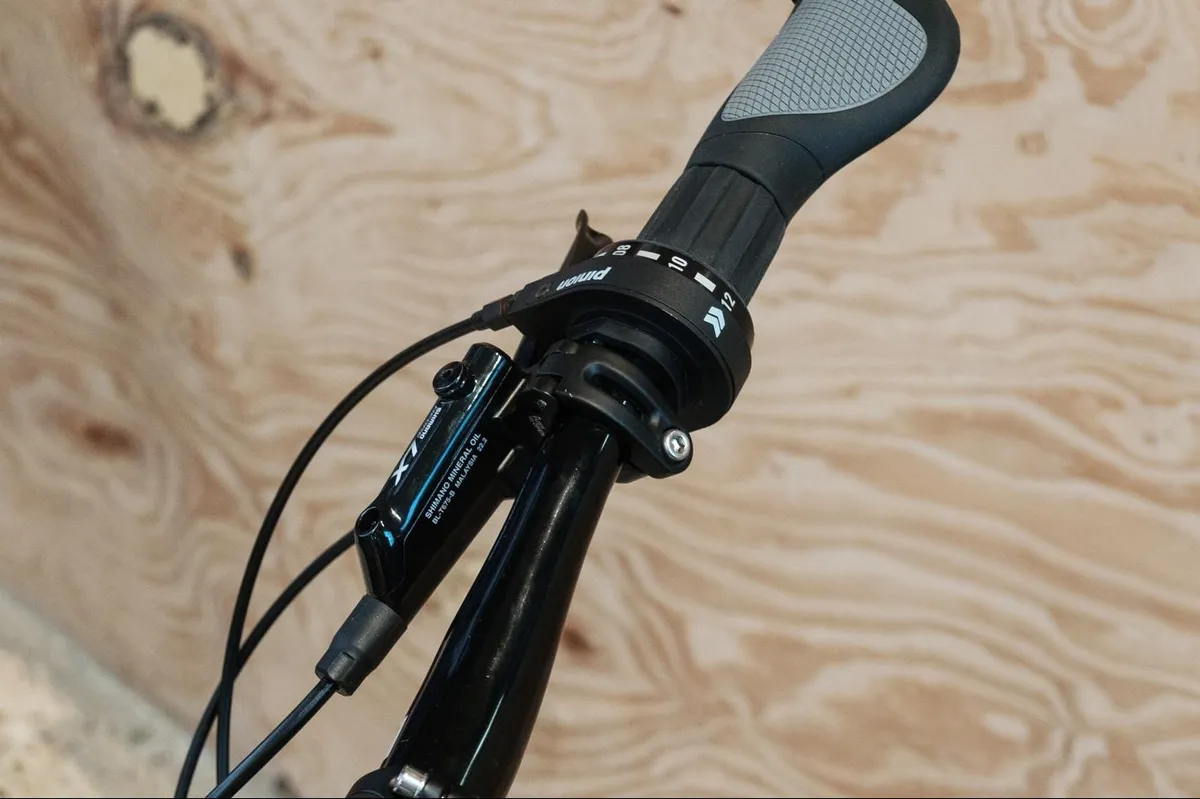
With a trigger shifter, you can usually only change one gear at a time, but with a grip shift, it’s possible to move through multiple gears very quickly.
The shifter integrates with the grip on your bar, and you change gears up or down by twisting the shifter – similar to the throttle on a motorbike.
How to use a thumb shifter
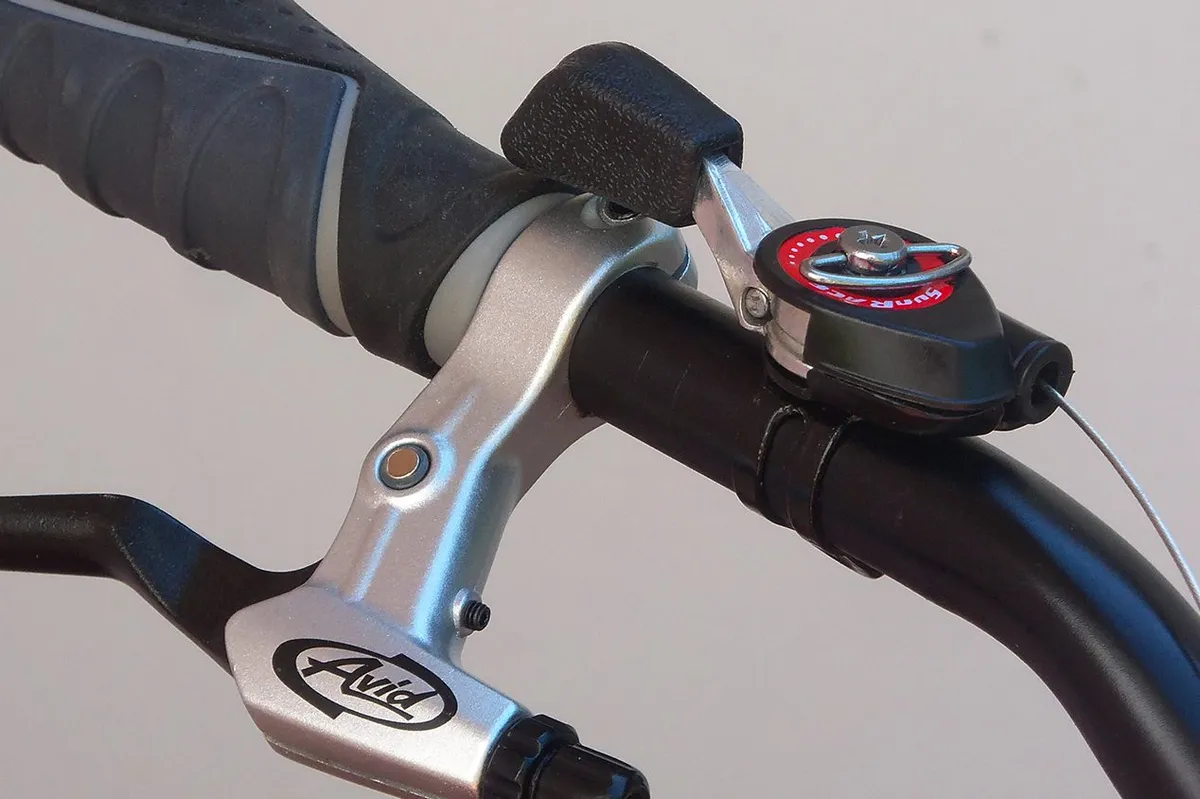
Though a little more old-school, thumb shifters still pop up from time to time.
A lever on top of your bars can be moved clockwise or anti-clockwise to move through your gears.
Modern gears are indexed, meaning a click on the gear shifter corresponds directly to a gear change.
In the past, shifters did not have this defined click and instead, the shifter was held in place by friction and moved continuously until the gear changed. In some rare cases, you may still encounter such thumb shifters.
How to use road bike shifters
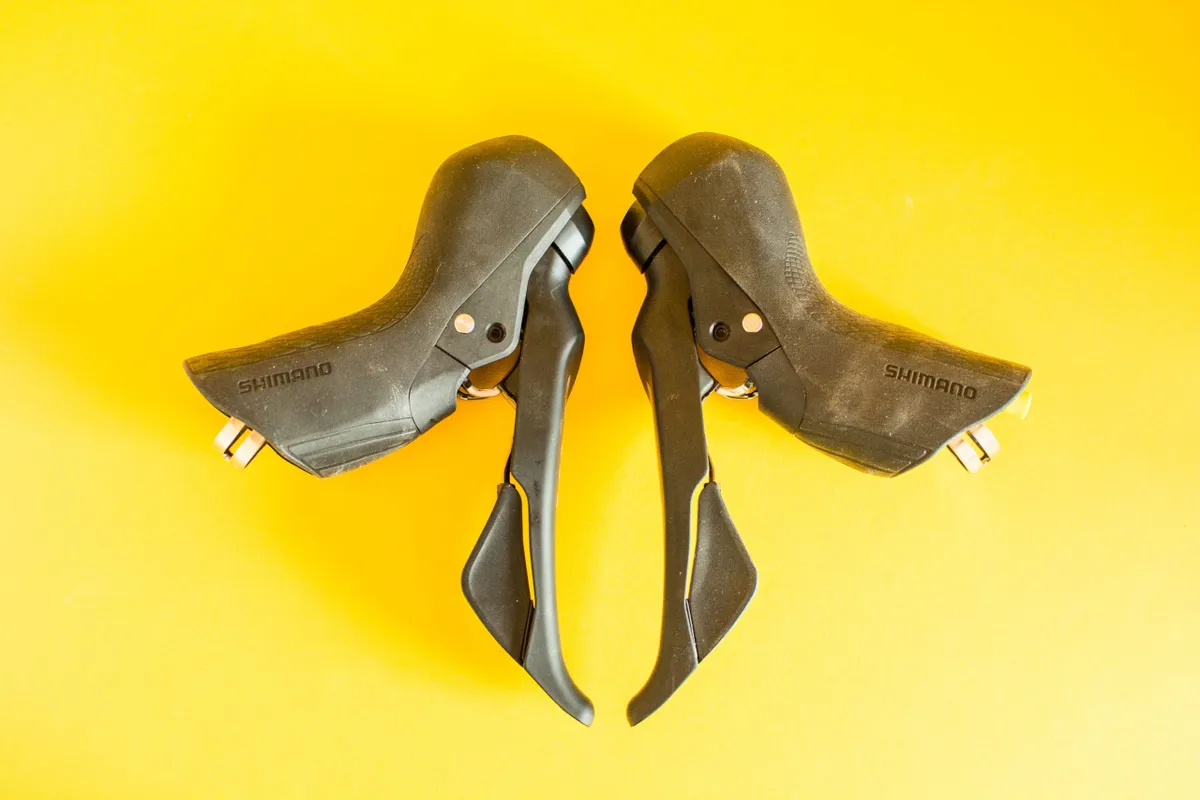
You’ll find drop bars on more dedicated road bikes aimed at speed rather than all-out comfort. Again, there are a few different designs available.
We have a separate guide on how to use road bike shifters .
How do the gears on my bike work?
Gear inches.
Your gears convert your input at the cranks into an output at the back wheel. Your cadence (how quickly you are pedalling) is converted into different speeds at your back wheel depending on whether you are in a high or low gear.
Your gear development – how far your bike moves with each pedal stroke – is typically described in gear inches, i.e. how many inches your bike will roll forward with each full rotation of your cranks.
There are a range of online calculators that work this out based on your wheel size, tyre size and chainring/sprocket sizes.
Gear inches can give you a good idea of how hard or easy the gears are, with ranges around 20 inches being easy, 70 inches being medium and above 100 inches getting quite hard.
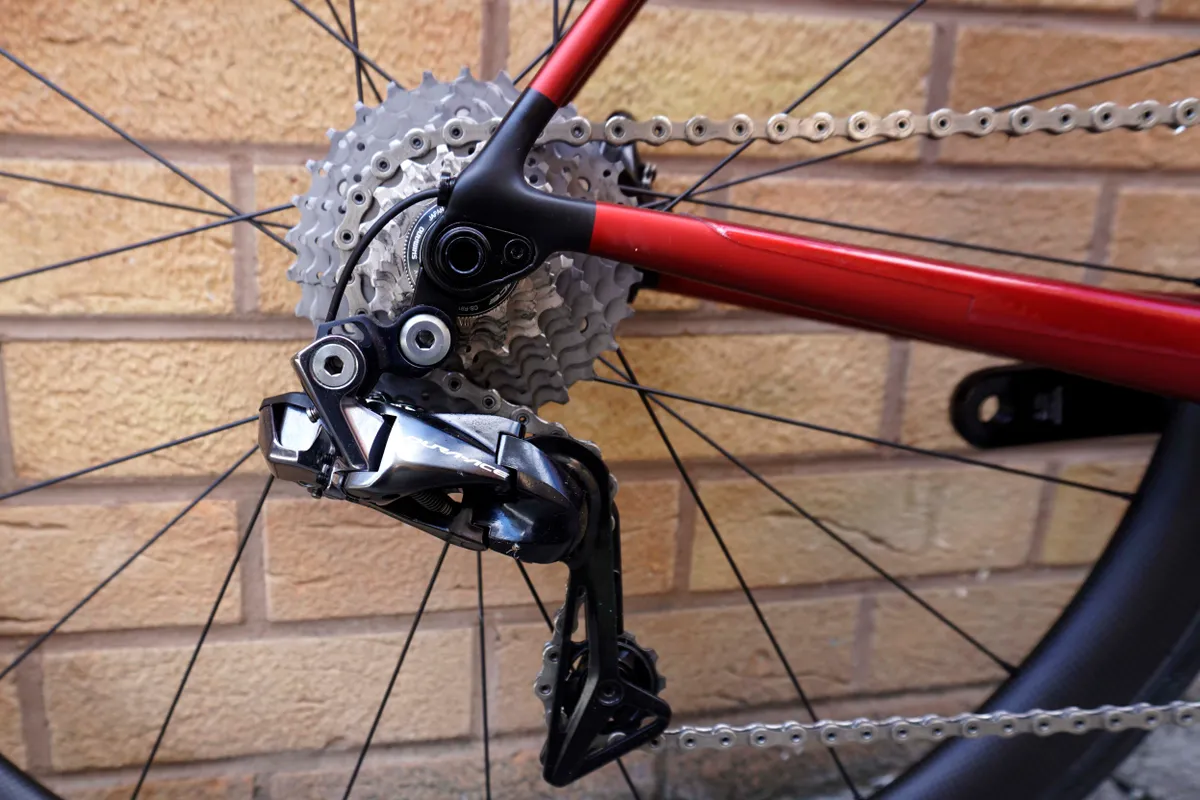
Gear range is often specified as a percentage that describes the overall range offered by the system. That means a 300 per cent range would offer a 3:1 ratio. Pedalling in the highest gear would move you three times as far forward per pedal stroke as in the lowest gear.
For external drivetrains, the gear range can be calculated by taking the ratio of the largest and smallest chainring teeth at the crankset multiplied by the ratio of the largest and smallest sprocket on the cassette.
The cassette specs will typically be identified by the smallest and largest sprocket. Thus an 11-28t cassette would denote a cassette with a smallest 11-tooth and largest 28-tooth sprocket.
Cranks come in a number of forms for road bikes, including standard, compact, super-compact and triple.
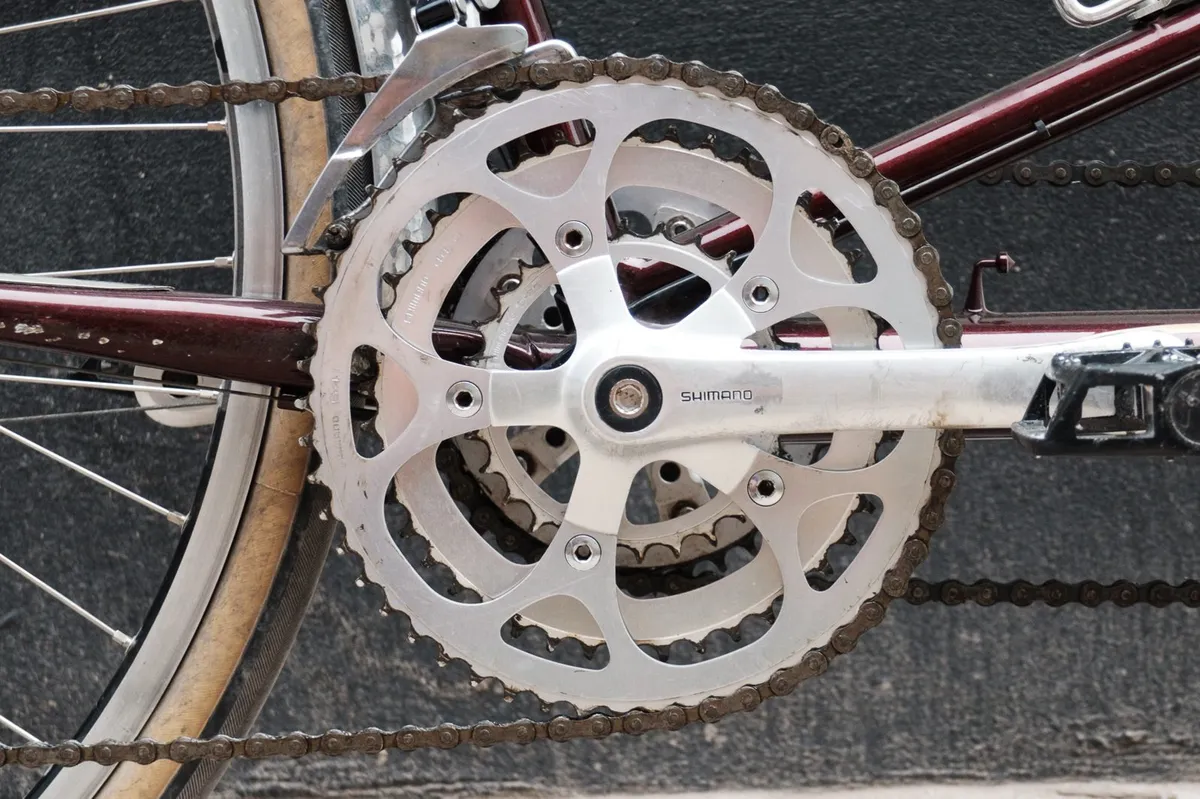
A triple crankset has three chainrings. While this was once the most widely used type of crankset, now it is found mainly on touring bikes or for hilly terrain, where you require a very wide range of gears.
Much more usual nowadays are bikes with two chainrings. These will come either on a standard or compact crankset, generally with 53/39t, 52/36t or 50/34t respectively. The standard is more suited to high speeds with the larger chainrings.
The compact provides a larger range and slightly easier gearing that is well suited for most cases for riding both at speed and climbing steep inclines.
On occasion, you may also find a super-compact crankset , which uses even lower ratios than the compact chainset, making the bike more suited to climbing.
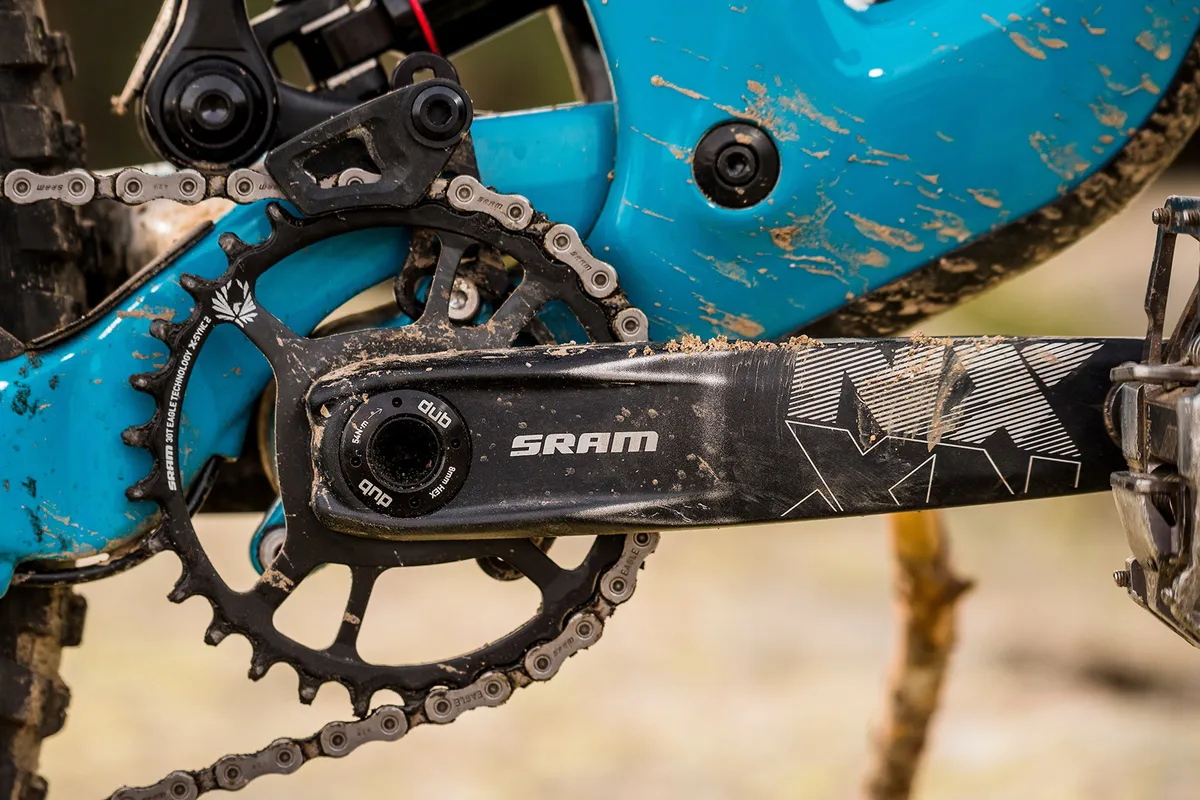
Mountain bike cranksets tend to use even smaller chainrings to deal with steep and off-road terrain. It's also now the norm to see most mountain bikes and many gravel bikes equipped with a single chainring up-front.
This is usually paired with a wide-range cassette at the rear. This arrangement is referred to as a 1x (one by) setup .
To figure out the number of gears you have, simply multiply the number of chainrings at the front by the number of cogs on your cassette at the back.
However, the number of gears can be a bit of a misnomer because similar gears may be duplicated depending on which chainring/sprocket combination you are using. Likewise, it may be inadvisable to use certain gear combinations because they can put the chain at an extreme angle.
For gear hubs and gearboxes, manufacturers will typically specify the range. For example, a 14-speed Rohloff hub has a 526 per cent range, while a Pinion P1.12 gearbox has a massive 600 per cent range.
What gear should I be in?
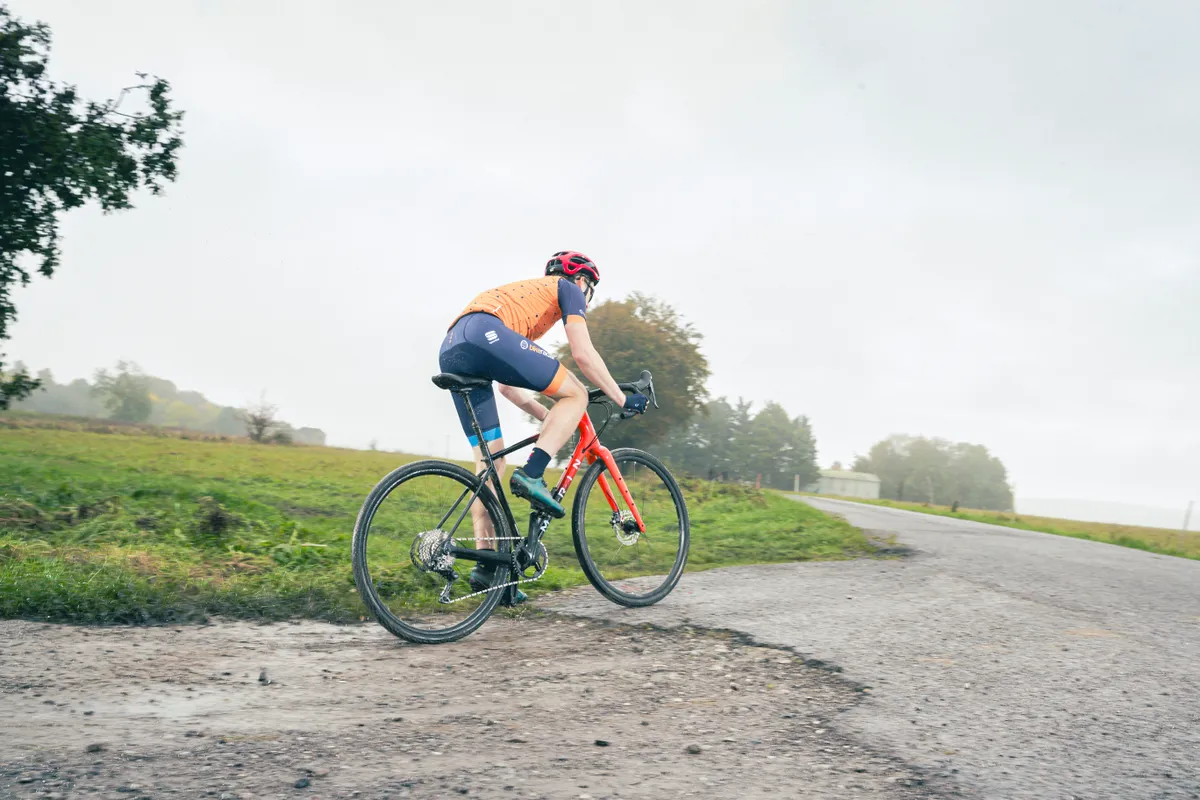
Gears are all about being efficient.
Imagine trying to pedal up a steep hill in a high gear. You would have to push incredibly hard on the pedals and grind your way up the hill.
Instead, in a lower gear your force input at the pedals is lower, but as a result you can spin faster.
Your energy input in each case is roughly the same. The work done is equal to the force times the distance – so if you halve the force input required, you’ll be pedalling twice as fast.
However, there’s a limit to how much force your legs can generate (and your knees can take), so there comes a point where it’s preferable to shift gears to reduce the required force input and increase your cadence.
The point about knee injuries really is a key one. It’s much nicer on your body to have to push relatively lightly (but more quickly) rather than having to grind your way along.
Conversely, there also comes a point where spinning any faster becomes inefficient and can even unbalance you. It makes sense to shift into a higher gear again in order to reduce your cadence.
You’ll quickly get a feel for what works for you, but the key is to strike a balance between having to push too hard or spinning far too quickly, enabling you to pedal smoothly. The ideal cadence will be very personal but is often considered to be in the 70 to 100rpm range.
When should I shift my gears?

The key thing with shifting gears is anticipation. Look ahead and try to predict how your speed will change and how you are likely to need to change gears.
As you come to a tight corner, anticipate that you will need to slow down and shift into a lower gear so you can accelerate out of the corner more easily.
If you’re riding up a hill or into the wind, your perceived effort will increase, so it makes sense to shift to a lower gear to account for that.
Equally, if you need to stop at some traffic lights, shift into an easier gear so you can set off more easily when the lights turn green.
One big no-no is that you shouldn’t shift when you’re at a standstill with an external drivetrain. Always ensure you are pedalling to perform smooth shifts and shift gradually across the range of gears to find the right one.
Another thing to avoid is cross-chaining . If you have multiple chainrings, it’s best to avoid being in a small-small or large-large sprocket-chainring combination.
The extreme angles this puts the chain at can result in increased wear and high loads on the drivetrain.
Conversely, hub gears or gearboxes can usually be shifted when at a standstill. In fact, they’re often quite sensitive to shifting under load, so it helps to ‘unload’ your cranks slightly when shifting.
How to clean your drivetrain
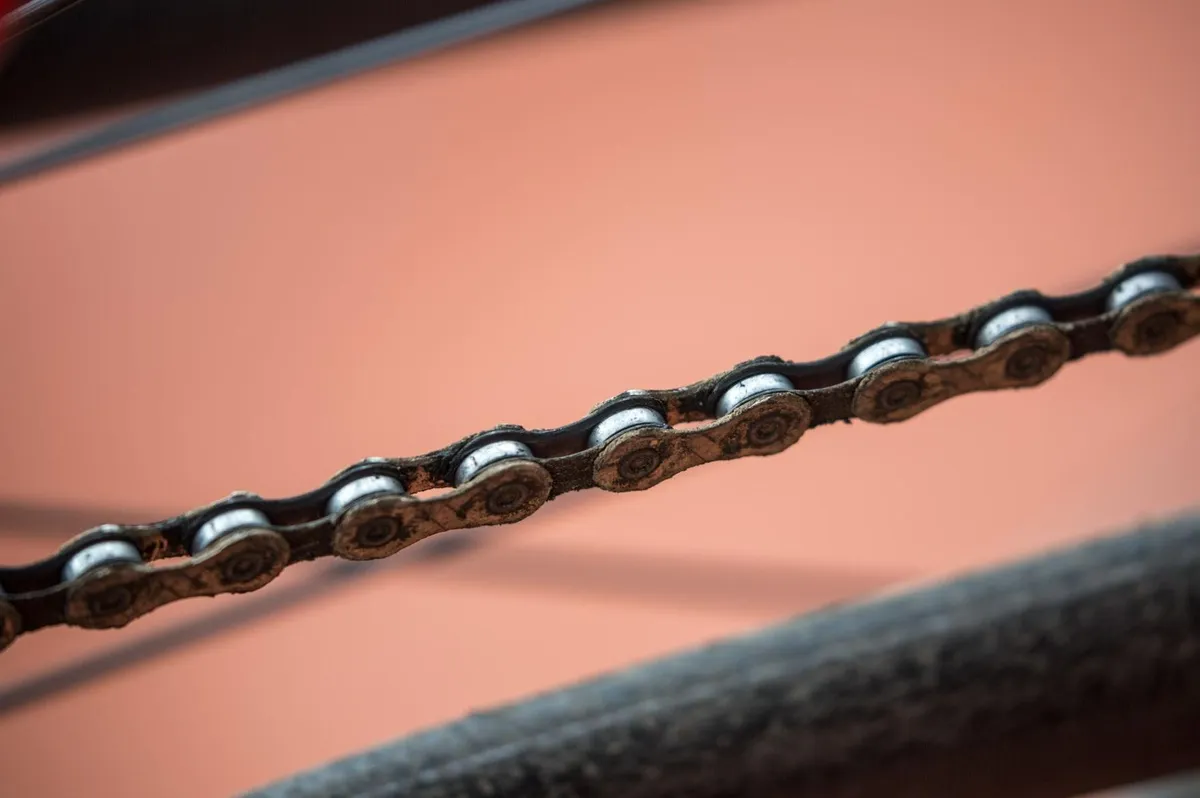
The key to keeping your gears running nicely is to ensure you keep them clean and well maintained. In fact, cleaning your bike in general helps you keep on top of maintenance and enables you to identify any potential issues before they become more serious.
As we've already covered, hub gears tend to be lower-maintenance, though you may still have to adjust cable tension because it stretches gradually over time.
General maintenance such as this works wonders in the long run because a well-adjusted and maintained bike is kinder on your components overall.
We've put together a guide on how to adjust the gears on your bike.
It’s also critical to clean your chain , by degreasing and lubing it regularly.

Finally, we would recommend checking your chain for wear regularly with a dedicated chain checker. Replacing a chain is much cheaper than replacing other worn-out components on your bike.
Equipped with this knowledge, get out there and start using your gears. You'll be flying up the hills in no time at all.
Share this article

- Terms & Conditions
- Subscribe to our magazines
- Manage preferences

- Stores Stores
Shifting Gears The ins and outs of using your gears effectively When you hear that a bicycle has "ten" or "twenty-seven" gears, it sounds complicated. It really just means that there are plenty of gears and that you'll have an easy time pedaling your bike regardless of what the road or trail throws at you. Still, having all those gears is daunting. You wonder which to use and how often to shift. Well, to put your mind at rest and have you shifting like a pro in no time, we've prepared this easy guide. You're The Engine One of the main sources of confusion is thinking of bicycle shifting in car terms. Bikes aren't shifted like cars. You don't start in first gear, shift into second, and so on. Instead, you shift by how your legs and lungs feel. As the engine for the bike, you're most efficient pedaling at a steady and maintainable pace (called "cadence," or the number of times one foot goes around in a minute). For most people a cadence of about sixty to seventy rpm (revolutions per minute) feels comfortable. Once you're pedaling comfortably, you shift gears every time you feel your legs starting to strain or spin too quickly. For the former, you shift to an easier gear. For the latter, you shift into a harder one. In other words, there's no right or wrong gear to be in. Just use the one that feels right for your legs and breathing at the time. This means that, unless you live where all the rides are pancake flat, you're shifting a lot to keep your pedaling cadence and riding effort steady, which ensure that you complete your rides comfortably. Changing Gears You probably already know that you must pedal in order to shift. And it's also important to ease the pressure off the pedals during the gear change. This makes the shift smoother and prevents possible drivetrain glitches. In order to do this on a hill, anticipate the steep section and shift into an easier gear before you get there. Shifting is done by moving the shift levers. You shift when your legs are working too hard or spinning too fast because conditions have changed. To make a good shift, all you need to know is whether you want to make it easier or harder to pedal and by how much. How do you know which lever to shift (never shift them simultaneously)? The right lever makes small differences in pedaling effort and is usually clicked once or several times. Shifting this lever moves the chain across the cluster of cogs on the rear wheel. On a newer bike, there are eight or nine cogs and they only vary slightly in size. The larger the cog, the easier it is to pedal and vice versa. Contrarily, the left lever makes larger differences in effort. Use it to make it considerably harder or easier to pedal. Operating this lever moves the chain between the two or three chainrings on the front of your drivetrain. Here, the larger the ring, the harder it is to pedal and vice versa. One way to remember where you are in the gears: When the chain is closer to the bike, front or rear, you're in your easier gears. As the chain shifts away from the bike (to the right), the gears get harder. A Shifting Example So, a short ride might go something like this: You roll out of your garage and start pedaling and find the going too difficult. You click the right lever once but it's still way too hard. So, you shift the left lever, which makes it much easier and lets you spin your legs at a good pace. You cruise toward the lake feeling fine but then your legs get heavy. A headwind! You shift the right lever twice and find a good rhythm again. Toward the backside of the lake, there's a short steep climb. You shift the right lever each time the hill steepens until you're in your easiest gear. Cresting the hill, it's all downhill home with a tailwind. Yes! You pick up speed quickly. You keep pedaling to match the wind's speed and get the workout. You shift the right lever but need a larger change so you shift the left and head for home lickety-split. You'll get better at shifting with practice so don't be afraid to shift a lot. You can't hurt the gears and it's the best way to familiarize yourself with them. After a few rides, shifting will become natural and you won't even think about it and all those gears (except for being glad every time the road heads uphill).
- ⋙ Start Here
Search suggestions:
Popular searches:.
- Best cycling jeans
- Urban cycling brands
- stylish helmets
- Gifts for cyclists
Bike Gears Explained: How to Use Bicycle Gears (for Dummies)
By Charlotte Broughton
Updated Mar 12, 2024
Contributors
This post may contain affiliate links, which help to keep Discerning Cyclist rolling. Learn more .
Bicycles often have a lot of gears. 7-speed bikes can be confusing enough, but what on earth do you do with 21 or even 28 gears?
In this article, we dive deeper into how bicycle gears work and explain how to use them correctly.
Bikes, though wonderful, can sometimes be a little confusing to use. This is especially true when considering how to use bicycle gears. There are a number of variations with gear components, and things can seem complicated – especially for beginners!
Bicycle Gears (for Dummies)
Let’s look at bike gears in nine easy steps. Click on the title below to jump to the section you’re interested in or simply keep scrolling down.
- How Do Bike Gears Work?
- How to Use Bike Gears as a Beginner
- 7-Speed Bike Gears Explained
- 21-Speed Bike Gears Explained
- How Many Bike Gears Do I Need?
- Pros and Cons of Gears on a Bicycle
- What Bike Gear to Use on a Flat Road
- What Gear to Use When Going Uphill on a Bike
- When Should You Shift Gears on a Bicycle?
1) Bike Gears Explained
Understanding how to use bicycle gears can be tricky, especially when you’re new to cycling, or haven’t ridden in a while.
However, getting the most out of your gears, and understanding when it’s best to change gear, can be a transformative skill that helps make cycling easier .
Figuring out how to use bicycle gears can also improve your overall efficiency, and most importantly, your enjoyment of cycling.
What Do Bicycle Gears Do?
Gears on a bicycle are there to allow you to maintain a comfortable cadence (the rhythm and tempo of your pedaling) whilst traveling at different speeds.
This allows you to access more varied terrain on your bicycle due to the range in gears. For example, the higher up the cassette the chain is, the easier it’ll be to ride uphill.
Types of Bicycle Gears
In order to correctly use the gears on your bike, you’ll need to figure out which kind of mechanism changes your gears.
There are many different types of bicycle gear shifting mechanisms. These can include:
- Twist-grip shifters
- Downtube shifters
- Bar-end shifter
- Trigger shifters
- Integrated road gear shifter and brake levers
All of the above gear mechanisms will be operated with your hands. The next step is to figure out how to use bicycle gears at the correct time.
2) How to Use Bike Gears as a Beginner
Firstly, a beginner should familiarise themselves with the gears on their bicycle in order to understand how to use bicycle gears. As you can only change gears while pedalling, this is an important skill to practice.
After this, the focus should shift to how to use bicycle gears when appropriate. We’ve covered an example of this – shifting to an easier gear when cycling uphill, to help make climbing more comfortable.
Beginner riders should try not to worry too much about always being in the correct gear! With time, it will become second nature.
Which Is the Easiest Bike Gear to Use?
The easiest gear on the bike will usually depend on the type of bicycle that you’re riding. However, a hybrid bike with 7 gears will have its ‘easiest’ gear at the top of the cassette, which is located on the rear wheel.
If the shifting mechanisms for your gears display numbers, the same ‘easiest’ gear on the cassette will be referred to as gear ‘1’. This gear is great for climbing and/or slow speed riding.
Gear 1 on a Bike Explained
Gear ‘1’ on a bike is a low gear: this is the same for gears in a car. This gear is best for climbing, riding over difficult terrain, and riding slowly.
This gear may also be referred to as the ‘easy’ gear.
3) 7-Speed Bike Gears Explained
A 7-speed bike is one that has a single chain ring (the round component that the chain sits on, and the cranks and pedals attach to) at the front, and 7 cogs at the back. This collection of cogs is referred to as a ‘cassette’.
Because the cassette is made up of 7 cogs (speeds) it provides 7 different gears. These gears will range from 1, which is the easiest gear, to 7, which may be referred to as a ‘high gear’ and is most suitable for riding fast downhill, or on the flat.
A 7-speed cassette is often found on city bikes, hybrid bikes , and children’s bikes. It offers a great range of gear options without being too complex to maintain or use. Hence, it’s very popular among commuters.
How Do You Use a Shimano 7-Speed Shifter
In order to use a standard Shimano 7-speed shifter to change gear, you’ll need to press the main shifter with your finger while riding forwards, every time you’d like to change into a lower gear.
You should press the other shifter (which tends to be a little smaller) with your finger to change into a higher gear.
With most types of gear shifters, there will be two gear levers/shifters to change the back gears, which will either take you into a higher or lower range.
What Is the Difference between a 1-Speed and 7-Speed Bike?
4) 21-speed bike gears explained.
Unlike a 7-speed bicycle, a 21-speed bike has 3 chainrings at the front of the drive chain. These three different chainrings allow for three times as many gear ratios to be created using the 7-speed cassette.
The 7-speed cassette is still present, it’s just now coupled with three different chain rings at the front which create 21 gears. There is also another handlebar shifter for these front gears, on the opposite side of the bars to the back gears.
These new chainrings create a wide range, especially useful for those looking to ride uphill or on varied terrain more often. The two smaller chainrings provide lower gear ratios.
Interestingly, the 21-speed option has become less popular in recent times. However, it’s still a great option for those looking for a wide gear-range, and is commonly seen on hybrid bicycles.
What Is the Difference between 7-Speed and 21-Speed Gears?
5) how many gears do i need on a bike.
This will depend on your cycling demands. These will include where you ride, how experienced you are, and how fit you are.
Riding in hilly areas will mean that you’ll want more gears coupled with lower gear ratios. In flatter areas you may be able to get away with a single speed bike , or even a fixie.
Stronger, more experienced riders may be more interested in larger gear ratios. These will be best suited to tackling steep climbs and varied terrains.
Commuters who want to regularly cycle to work may want to look at more low maintenance options. A 7-speed bike is a popular choice here. There’s still a good range of gears, and they benefit from being simple and quick to maintain, or fix on the go.
Overall it’s down to individual needs and preferences. I’d always suggest trying a few different speed options on bikes, either through bike shops or renting.
Does the Number of Gears on a Bike Matter?
The number of gears do matter, as they can determine what your bike can and can’t do. For example if you want to do lots of road riding in a hilly area, but only have a single speed bike, it’s going to cause an issue.
So again, it does depend on where you ride, and the style of riding you do!
Are 3 Gears Enough on a Bike?
Three gears could be more than enough if you’re cruising around a fairly flat area. On the other hand, having only 3 gears may be an issue.
This is because the lack of range having only 3 gears offers limits your riding, and won’t be great for riding in hilly areas.
Do You Need 21 Gears on a Bike?
You may need 21 gears on your bike if you’re planning to ride up substantial hills, or over varied off-road terrain. You may also prefer having a greater range if you’re just getting back into regular exercise.
Overall, it does really depend on where you’re planning to ride, and the style of riding you do. But for urban or bike path use, most 7-speed bicycles will be adequately geared.
6) Is It Better to Have More Gears on a Bike (PROS + CONS)
Having more gears may seem like a great solution when it comes to versatility, however there are pros and cons.
- Wider range of gears
- Suitable for different terrains
- Better for riding uphill/slow speed
- More gears means more parts to maintain/replace
- Extra shifter to consider with gears on the front
- Makes the bike heavier as there’s more equipment
7) What Bike Gear to Use on a Flat Road
In order to figure out what gears would suit riding on a flat road, starting off with a 7-speed bike would be a great idea. You may find you personally need more range, or less.
In general, either a 7-speed or 3-speed bike would allow for a comfortable cadence and speed to be maintained along a flat road. At the end of the day, it’s down to individual preference.
8) What Gear to Use When Going Uphill on a Bike
Whilst climbing uphill on a bike, you’ll want to use a lower (easier) gear. This will allow you to travel more slowly, as well as maintain a comfortable cadence.
Riding uphill requires more effort to maintain the same speed. Therefore a lower gear ratio will offer improved comfort, and hopefully make climbing less tiring, and a little easier!
9) When Should You Shift Gears on a Bicycle?
As a general rule, you should try to shift gears just before you’re about to change speed, or when changing the terrain or gradient that you’re riding on.
A great tip is to change gear in anticipation of a climb. This can really help to carry your momentum into the climb, as you won’t have to ease off of the pedals in order to change gear mid-climb.
Similarly, changing gear when traveling fast at a higher cadence will help to make the gear change feel smoother, as well as faster.
10) How Do You Maintain and Service Bicycle Gears to Ensure They Are Functioning Optimally?
Maintaining and servicing bicycle gears to ensure they function optimally involves a series of careful steps and regular attention. Firstly, it’s crucial to keep the gears clean, as dirt and grime can build up and hinder performance. This means regularly wiping down the chain, derailleur, and sprockets with a suitable cleaner and a rag. After cleaning, applying a quality lubricant to the chain and moving parts of the derailleur is essential. This reduces friction and wear, allowing for smoother gear shifts.
Adjusting the derailleur is another vital aspect of maintenance. This ensures that the chain moves correctly between gears without slipping or making noise. It requires checking the alignment of the derailleur, adjusting the tension of the cable using the barrel adjuster, and ensuring the limit screws are correctly set so the chain doesn’t fall off the gears.
Regularly inspecting the chain for wear is also important. A worn chain can damage the gears, leading to poor performance and the need for more significant repairs. If the chain is stretched or has damaged links, it should be replaced.
Servicing bicycle gears might also involve professional help from time to time, especially for more complex issues or when preparing for a comprehensive overhaul. A professional bike mechanic can ensure that all components of the gear system work together seamlessly, providing an optimal cycling experience.
By adhering to these maintenance practices, cyclists can significantly enhance the longevity and performance of their bicycle gears, ensuring a smooth and efficient ride.
11) What Are the Most Common Issues or Mistakes Beginners Make When Shifting Gears, and How Can They Be Avoided?
Beginners often encounter several common issues or mistakes when learning to shift gears on a bicycle, which can affect their riding experience and the mechanical integrity of the bike. Understanding these issues can help in avoiding them and ensuring smoother rides.
One common mistake is cross-chaining, which occurs when the chain is on the largest front gear and the largest rear gear, or the smallest front gear and the smallest rear gear. This extreme angling of the chain can cause excessive wear on the drivetrain and lead to inefficient pedaling. To avoid this, riders should shift gears in a way that keeps the chain as straight as possible, matching front and rear gears appropriately.
Another issue is shifting under load, which happens when a rider tries to change gears while pedaling hard, such as when climbing a hill. This can lead to the chain skipping, jumping, or even falling off, as the derailleur cannot smoothly guide the chain from one gear to another under high tension. To prevent this, cyclists should anticipate the terrain and shift gears before the pressure becomes too great, easing off the pedal pressure momentarily as they shift.
Not using the full range of gears available is also a common oversight. Beginners might stick to a single gear or a narrow range of gears, not fully utilizing the bike’s capability to handle various terrains and inclines efficiently. Learning to shift through gears effectively, based on the terrain and the desired speed or effort level, can make cycling more enjoyable and less physically demanding.
Lastly, neglecting regular maintenance of the gear system can lead to poor shifting performance over time. Keeping the drivetrain clean and lubricated, and ensuring the gears are correctly adjusted, are fundamental practices that can prevent many shifting issues.
By being mindful of these common mistakes and taking proactive steps to avoid them, beginners can improve their cycling skills and enjoy a better riding experience.
12) How Does Gear Usage Vary between Different Types of Cycling (e.g., Road Biking, Mountain Biking, Commuting)?
Gear usage varies significantly between different types of cycling, such as road biking, mountain biking, and commuting, due to the varying demands of each discipline. These differences influence how cyclists choose and use their gears to optimize performance, comfort, and efficiency.
In road biking, the emphasis is often on speed and endurance over long distances on paved surfaces. Cyclists use gears to maintain an efficient cadence (pedal speed), typically aiming for 80 to 100 revolutions per minute (RPM). This requires a fine-tuning of gear selection to match the terrain, whether climbing steep hills, cruising on flat roads, or descending. Road bikes usually have a wide range of gears, allowing riders to make small adjustments to find the perfect gear for maintaining speed without overexerting themselves.
Mountain biking, on the other hand, involves navigating off-road trails with varying terrain, including steep inclines, descents, and technical sections. Gear usage in mountain biking is more about managing the bike’s traction and the rider’s power output than maintaining a specific cadence. Riders frequently shift gears to adapt to rapid changes in terrain, using lower gears for climbing steep hills and higher gears for flat sections or descents. The focus is on selecting a gear that allows for effective power transfer without causing the rear wheel to slip or making the pedals too hard to turn.
Commuting cycling blends aspects of road and mountain biking gear usage, with a focus on comfort and reliability. Commuters prioritize gears that help them navigate urban environments efficiently, which includes stopping and starting at intersections, riding on flat streets, and occasionally dealing with hills or uneven road surfaces. The gear range for commuting bikes may not be as wide as that of road or mountain bikes, but it’s versatile enough to handle the typical urban terrain. Commuters often favor a gear that allows for a moderate cadence, enabling them to accelerate quickly after stops while also being comfortable for longer, steady stretches of riding.
Overall, the variation in gear usage across cycling disciplines reflects the different challenges and priorities of each type of riding. Cyclists adjust their gear selection to manage their effort, maintain control, and maximize efficiency, whether they’re racing on a road, navigating a mountain trail, or commuting through city streets.
Discerning Cyclist Store
Visit the Discerning Cyclist's Shop
Ride in style
Join our weeky newsletter to get early access to our latest discoveries.
Related reads
Flat tire no problem here’s a step-by-step guide.
By Herman Eloff
10 Facts About Cycling to Work That Will Encourage You to Ride Even More
5 common cycling challenges in the city and how to overcome them, beautiful beasts: 8 eye-catching bikes we’re obsessed with right now, the perfect bike setup for women: 5 tips for maximum comfort , 6 things female cyclists are tired of hearing .

Mastering Gear Shifts: A Step-by-Step Guide for Trek Road Bikes
Rony Tushar
June 18, 2023
To change gears on a trek road bike, use the left shifter to shift the front gears and the right shifter to shift the rear gears. Now, let’s explore how to effectively change gears on your trek road bike with a step-by-step guide.
Riding a bike is a great way to enjoy some exercise while getting to your destination. A trek road bike is a great option for anyone interested in road biking, as it is designed with performance and comfort in mind.
Changing gears while riding can make your journey smoother and ensure that you are efficiently using your bike’s power. However, it can be intimidating for beginners to know when and how to shift gears. With a basic understanding of gear shifting, anyone can easily and effectively change gears on their trek road bike.

Credit: cyclingmagazine.ca
Table of Contents
Understanding The Different Gears On Your Trek Road Bike
Riding a bike is a fun and healthy way to get exercise, but it can be intimidating for beginners to navigate all of the gear options. Understanding the different gears on your trek road bike can make a big difference in your ride experience and help you get the most out of your workout.
Here are some key points to keep in mind:
- Your trek road bike has multiple gears that can be adjusted using the shifters on your handlebars. These gears control how much resistance you face when pedaling, allowing you to tackle hills and inclines more easily or pick up speed on flat terrain.
- The most common type of gears on a road bike are called “derailleur gears”. These gears work by moving your bike’s chain from one sprocket to another in order to adjust the resistance you feel when pedaling.
- Understanding how to shift gears properly is essential to get the most out of your ride. Shifting too quickly or too often can cause your chain to fall off, while not shifting enough can make it difficult to pedal on hills or increase your speed.
- Once you get used to using your bike’s gears, you’ll be able to get a feel for which gear is appropriate for different riding situations. For example, you’ll want to use a lower gear for uphill climbs and a higher gear for downhill descents or flat terrain.
Understanding The Gear Ratios And How They Affect Your Ride
Each gear on your trek road bike has a different ratio that determines how much your bike’s wheel will turn with each pedal stroke. In general, higher gears (i. e. , those with a higher numerical ratio) will provide more forward momentum with each pedal stroke, while lower gears (i.
e. , those with a lower numerical ratio) will provide less forward momentum but more control and power.
Here are some key points to keep in mind when thinking about gear ratios:
- Understanding your bike’s gear ratio is important because it can affect your pedaling cadence, making it either more difficult or easier to pedal at a given speed.
- Switching to a higher gear ratio can help you go faster, but it will also make it harder to pedal and may cause you to tire more quickly.
- On the other hand, using a lower gear ratio can help you tackle steep hills or provide greater control when navigating tricky terrain.
- Ultimately, the best gear ratio for your ride will depend on the terrain, incline, wind conditions, and your own physical ability and comfort level.
The Benefits Of Using The Correct Gear For Different Terrains And Inclines
Using your trek road bike’s gears properly can make a big difference in your riding experience and help you get the most out of your workout. Here are some key benefits of using the correct gear for different terrains and inclines:
- Better efficiency: Using the right gear can help you maintain a consistent pedal cadence and conserve your energy, which can help you ride longer and more effectively.
- Increased speed: Shifting to a higher gear can help you pick up speed on flat terrain and enjoy a more efficient ride.
- Enhanced control: Using a lower gear can help you navigate steep hills or technical terrain safely and with greater control.
- Less risk of injury: Using the correct gear can reduce strain on your joints and muscles, which can help prevent injury and allow you to ride pain-free.
Overall, understanding how to use the gears on your trek road bike can make a big difference in your riding experience. With practice and experience, you’ll be able to master shifting gears and choose the right gear for any given ride, allowing you to enjoy the benefits of cycling to the fullest!
Getting Started With Gear Shifting
A trek road bike is an exceptional bike for enthusiasts who love speed and adventure. Changing gears on a trek road bike is an essential skill that any rider should possess. Proper gear shifting is vital to ensure a smooth ride and avoid any unnecessary strain on the body.
Here’s a step-by-step guide to get you started:
Proper Hand Placement On Handlebars For Shifting
- Place both hands on the handlebars, positioning your fingers around them, with your thumbs underneath them.
- The right hand triggers the rear derailleur which controls the bike’s cassette gears.
- The left hand controls the front derailleur and is responsible for gear changes of the chainrings.
Understanding The Gear Indicators And How To Read Them
- Before changing gears, take note of the gear indicator found on the handlebars.
- The gear indicator will display which gear chainring and cassette gear you are currently using.
- The chainrings are the larger gears next to the pedals, whereas the cassette gears are the smaller cogs on the rear wheel.
- Higher gears are indicated by higher numbers, whereas lower gears are indicated by lower numbers.
Tips For Making Smooth Gear Transitions While Riding
- Change gears before you need to. Don’t wait until a steep hill or a sprint to shift, plan ahead and choose the correct gear in advance.
- When shifting, stop pedaling for a moment, shift gears, and start pedaling again.
- During gear transitions, ensure that there’s minimal power transfer through the pedals. This minimizes gear slippage and chain wear.
- Using a single-gear shift at a time ensures a smoother ride and reduces the likelihood of chain and derailleur malfunctions.
- Avoid cross-chaining, a situation where you use the smallest chainring in the front and the smallest cassette gear in the back, or the largest chainring in the front and the largest cassette gear in the back. This puts unnecessary pressure on the bike’s chain, causes wear, and reduces its lifespan.
Changing gears on a trek road bike is a fundamental skill, but with practice, it becomes second nature. Remember to shift smoothly, choosing the right gear for the terrain, and anticipate changes before you start to climb or sprint. Happy cycling!
Mastering Gear Shifts For Uphill And Downhill Terrain
Changing gears on a trek road bike can seem challenging, but with adequate knowledge and practice, it can be a breeze. Mastering gear shifts for uphill and downhill terrain requires familiarity with the various gears available, the terrain, and your individual fitness level.
In this blog post, we’ll discuss three strategies for tackling hilly terrain and adapting your gears to them: techniques for tackling steep uphill climbs, adjusting gears for downhill descents, and strategies for maintaining speed and control on hilly terrain.
Techniques For Tackling Steep Uphill Climbs
When it comes to uphill climbs with a road bike, things can get tough, but with the right technique and gear selection, you can make it through. Here are some key points:
- Always shift to a lower gear before starting an uphill climb to allow easy pedaling.
- Keep a steady, comfortable pace, and try to maintain it until the end of the climb.
- Keep your body weight centered on the bike, and avoid leaning too far forward or backward.
- Keep your upper body relaxed and focused on breathing.
- Use your gears wisely by shifting up gradually as you gain momentum.
Adjusting Gears For Downhill Descents
Descending hills at high speeds can be thrilling, but it can also be dangerous if you don’t control your speed. With these key points, you can have a safe and enjoyable descent:
- Shift into a higher gear to avoid excessive pedaling and maintain speed.
- Keep your body weight centered on the bike and your arms relaxed.
- Focus on the road ahead, anticipate turns, and brake in advance to maintain control.
- Shift your weight back slightly to maintain balance on steep descents.
- Use your gears wisely by shifting down gradually as you slow down.
Strategies For Maintaining Speed And Control On Hilly Terrain
When facing hilly terrain, maintaining speed and control can seem like a daunting task. However, with these key points, you can handle it with ease:
- Be mindful of your energy levels and adjust your gears accordingly.
- Keep a steady cadence by shifting gears as necessary to prevent muscle fatigue.
- Anticipate the terrain ahead and shift gears in advance to maintain momentum and speed.
- Stay hydrated, fueled, and focused on the ride, and take breaks when necessary.
- Seek professional help if you struggle with gear selection.
By mastering these gear shifting techniques, you can become a pro at tackling uphill and downhill terrain. With patience, practice, and dedication, you will become more confident and have a fantastic riding experience. Remember to always prioritize safety, and don’t push yourself beyond your limits.
Now it’s over to you – get out there, enjoy the ride, and conquer those hills!
Troubleshooting Gear Shifting Problems
Changing gears on a trek road bike takes practice and a little bit of know-how. However, even with practice, sometimes gear shifting problems pop up, which can be frustrating. In this section, we will focus on some tips to troubleshoot these issues.
Common Gear Shifting Issues And Their Causes
- Misaligned derailleur hanger: Shifting issues often occur due to not aligning the rear derailleur hanger properly, which can cause the chain to slip or make a grinding noise.
- Worn-out shift cables and housing: Old shift cables can stretch, fray, or become stiff, leading to inconsistent or sluggish gear changes.
- Poorly adjusted limit screws: Limit screws control the range of motion of your derailleur. If they’re not correctly adjusted, the chain can rub or fall off the cassette.
- Dirty chain: Grime and dirt buildup can cause your chain to shift poorly, so make sure to clean and lubricate it often.
Tips For Adjusting And Maintaining Your Bike’S Shifting Mechanism
- Check the gear shift index: Check your gear index by shifting up and down while pedaling your bike. If you notice a delay in the gear changing process or hear any clicking noise, it means the shift indexing is off, and you need to adjust it.
- Adjust the limit screws: Adjust both high and low limit screws of the gully to ensure the bike stays in gear before and after each shift.
- Lubricate the cables and housing: Lubricating the shift cables and housing helps keep the shifting mechanism smooth, consistent, and friction-free.
- Keep the chain clean: Regularly clean and lubricate the chain to keep the shifting mechanism working correctly.
Knowing When To Seek Professional Help For Gear-Related Issues
Sometimes, gear issues are too tricky or require more complicated fixes, which are best left to professionals. Here are some scenarios in which you should consider seeking professional help.
- Excessive chain skipping while shifting
- Difficulty downshifting, especially under load
- Loose or wobbling derailleur
- Damaged or bent derailleur
By following these simple tips and tricks, you can keep your trek road bike shifting correctly and smoothly.
Frequently Asked Questions On How To Change Gears On A Trek Road Bike
How many gears does a trek road bike have.
Most trek road bikes come equipped with either 18 or 22 gears.
How Do I Know When To Change Gears?
You should change gears when you feel resistance or find it difficult to pedal.
How Can I Change Gears Smoothly On My Trek Road Bike?
Shift gears one at a time, using light pressure to avoid chain slipping or breakage.
What Gear Should I Use For Uphill Climbs?
Use a lower gear for uphill climbs to make pedaling easier and prevent fatigue.
Changing gears on a trek road bike is a necessary skill to have when cycling. It’s important to understand how to shift gears properly to ensure a smooth ride and avoid any potential damage to the bike. With these simple steps, you can quickly and easily change gears on your trek road bike.
Remember to keep pedaling while shifting gears, and make small adjustments to the chain to avoid abrupt changes. Pay attention to the terrain and adjust gears accordingly. With practice, you’ll be able to change gears naturally and intuitively without even thinking about it.
So, don’t be intimidated by the gears on your trek road bike. Take it step by step and soon you’ll be shifting gears like a pro. Happy biking!
Related posts:
- Mastering Road Bike Shifters: A Complete Guide
- Mastering Gear Change: When to Shift Gears on a Road Bike
- How Do Road Bike Gears Work: A Beginner’s Guide
- Mastering Gear Changes: A Guide to Specialized Road Bikes
Why Bike Headlights Are Always On: Safety or Law?
Pedal Longer: Road Bike Saddle Lifespan Revealed
Bicycle Stories
"Exploring the world of road bikes, gear, maintenance, and more - join us on a journey of cycling discovery with Bicycle Stories."
Latest Post
- How Can I Improve My Bike Brakes? Expert Tips!
- How to Adjust Road Bike Brakes Rubbing with These Easy Steps
- Unlocking the Truth: Are Cannondale Road Bike Gears Good?
- What Road Bike Gears for Dummies: The Ultimate Guide.
- Shimano Road Bike Gears Good or Bad for Cycling?
© 2024 Bicycle Stories | All Rights Reserved
HYBRID BUYER'S GUIDE
How to choose the best hybrid bike
- filter controls Items 24 24 48 72 filter controls Sort by Featured Featured A-Z Z-A Price Low-High Price High-Low
NEED HELP CHOOSING?
Use the Bike Finder to narrow your choices, compare models, and find the Trek that’s right for you.
Get started

- Regions
- Russia
- Moscow Oblast
Elektrostal
Cycling routes in
Find the right bike route for you through Elektrostal, where we've got 330 cycle routes to explore. The routes you most commonly find here are of the hilly type. Most people get on their bikes to ride here in the months of June and August.
Find cycle routes in Elektrostal:
Flat routes | Hilly routes | Uphill routes | Downhill routes | Quick rides | Long tours | Top rated routes
Join the fast growing global cycling community
Are you ready for the full cycling experience.

- New comments
- Military Photos
- Russian Military
- Anti-Aircraft
- SA-21/S-400 Triumf
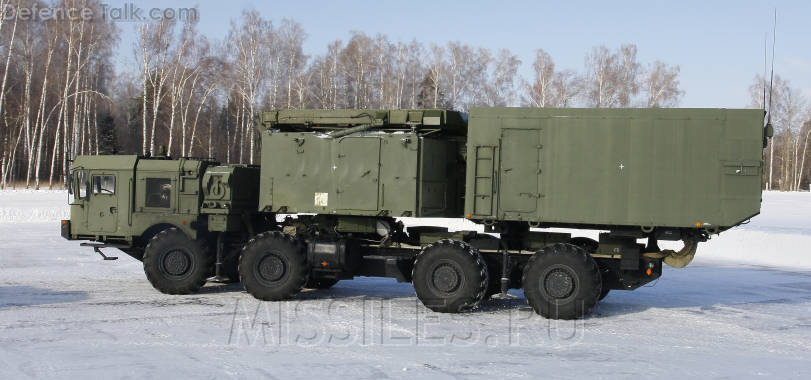
92N6E Radar, S-400
- Oct 18, 2010
Media information
Share this media.
- This site uses cookies to help personalise content, tailor your experience and to keep you logged in if you register. By continuing to use this site, you are consenting to our use of cookies. Accept Learn more…

Victor Mukhin
- Scientific Program

Title : Active carbons as nanoporous materials for solving of environmental problems
However, up to now, the main carriers of catalytic additives have been mineral sorbents: silica gels, alumogels. This is obviously due to the fact that they consist of pure homogeneous components SiO2 and Al2O3, respectively. It is generally known that impurities, especially the ash elements, are catalytic poisons that reduce the effectiveness of the catalyst. Therefore, carbon sorbents with 5-15% by weight of ash elements in their composition are not used in the above mentioned technologies. However, in such an important field as a gas-mask technique, carbon sorbents (active carbons) are carriers of catalytic additives, providing effective protection of a person against any types of potent poisonous substances (PPS). In ESPE “JSC "Neorganika" there has been developed the technology of unique ashless spherical carbon carrier-catalysts by the method of liquid forming of furfural copolymers with subsequent gas-vapor activation, brand PAC. Active carbons PAC have 100% qualitative characteristics of the three main properties of carbon sorbents: strength - 100%, the proportion of sorbing pores in the pore space – 100%, purity - 100% (ash content is close to zero). A particularly outstanding feature of active PAC carbons is their uniquely high mechanical compressive strength of 740 ± 40 MPa, which is 3-7 times larger than that of such materials as granite, quartzite, electric coal, and is comparable to the value for cast iron - 400-1000 MPa. This allows the PAC to operate under severe conditions in moving and fluidized beds. Obviously, it is time to actively develop catalysts based on PAC sorbents for oil refining, petrochemicals, gas processing and various technologies of organic synthesis.
Victor M. Mukhin was born in 1946 in the town of Orsk, Russia. In 1970 he graduated the Technological Institute in Leningrad. Victor M. Mukhin was directed to work to the scientific-industrial organization "Neorganika" (Elektrostal, Moscow region) where he is working during 47 years, at present as the head of the laboratory of carbon sorbents. Victor M. Mukhin defended a Ph. D. thesis and a doctoral thesis at the Mendeleev University of Chemical Technology of Russia (in 1979 and 1997 accordingly). Professor of Mendeleev University of Chemical Technology of Russia. Scientific interests: production, investigation and application of active carbons, technological and ecological carbon-adsorptive processes, environmental protection, production of ecologically clean food.
Quick Links
- Conference Brochure
- Tentative Program


IMAGES
VIDEO
COMMENTS
Here's where I'd start out: Roughly 60″-70″ is appropriate for flat areas, so that's where middle gears tend to fall. A low around 30″-35″ (at most) is nice for steep climbs. Go even lower for heavy loads and/or steep unpaved roads. A high around 90″-95″ (at least) is helpful on descents.
Understanding Front Gears. The front gears, also known as chainrings, are located next to the pedals and are controlled by the left gear shifter. Hybrid bikes usually have two or three chainrings, each with a different number of teeth. The number of teeth determines how hard or easy it is to pedal the bike. The smaller the number of teeth, the ...
If you are new to cycling, shifting gears on a hybrid bicycle can be a bit tricky. However, once you master the technique, it can significantly enhance your riding experience. We provide a guide on how to shift gears on hybrid bicycles, including tips and tricks to help you shift gears more smoothly. Whether you are commuting or going for leisure rides, this guide will equip you with the ...
The big lever moves you to the big (harder) ring. The small lever moves you to the small (easier) ring. Choose your gear early. Don't shift when your pedals are under load, like when going uphill. Choose your climbing gear early so you're ready for the hill. If you do need to change gears under load, try to ease up on the pedals while shifting.
Hybrid bikes fill many functions. They're great for fitness, commuting, adventuring, recreation, and more. Plus, each bike is designed for a comfortable and fun riding experience. Every Trek Hybrid bike is versatile and can be ridden on a variety of surfaces, but each model has specific strengths. Some are especially fast on pavement and ...
Wheels and Tires. Wheels and tires are among the main differences between FX, Verve, and Dual Sports. While FX and Verve use 700c wheels with 35-45mm tires, Dual Sports have 650b wheels with 50mm tires. This makes Dual Sport bikes more suitable for off-road riding as they absorb larger bumps and have better traction.
A hybrid bike is a combination of a road bike and a mountain bike. It is designed to be fast on smooth roads and capable on rough terrains. The gears of a hybrid bike are an essential part of the bike's design to help you ride effortlessly on different terrains. The mechanism of a hybrid bike's gears consists of multiple sprockets in the ...
Step I: Understand Your Hybrid Bike. By this I simply mean you should understand your bikes gear mechanism. To do so you should at the following. Your drive train; from the chain rings to the free-wheel. Make sure you look at the big chain sprockets at the pedals too. Master the cluster of sprockets at the rear wheel/ connecting chain.
56 Comments. This 2022 Trek FX 3 review covers everything you need to know about the best hybrid bike for 2022. The 2022 Trek FX 3 checks all the boxes: disc brakes, 1X drivetrain, tubeless ready wheels and more! Its a fitness hybrid, which means you can ride it like a flat bar road bike while staying comfortable, or use it to commute around town.
The majority of bikes use a derailleur gear system. This comprises a series of sprockets with a range of sizes attached to the rear hub, which form a cluster called a cassette. In modern systems ...
The Verve 3 is Trek's top-dog in this range of hybrid bikes and ensures you get all the best quality parts for an excellent price. The inclusion of a full Shimano Acera groupset really gives the Verve 3 an extra touch of class. Men's Verve 3 Disc comes in four sizes (S, M, L, XL) and two colors: Metallic Gunmetal and Mulsanne Blue.
This means the same shifting motions you use with your left hand deliver the opposite result with your right hand. By pushing the whole right hand lever inward, the rear derailleur shifts the chain to a bigger cog—an easier but slower gear. Pushing the smaller inner lever inward will shift the chain to a smaller cog—a harder but faster gear.
Our complete guide to gears introduces the different types of gearing used on bicycles, how they work and how to use them.
Shifting this lever moves the chain across the cluster of cogs on the rear wheel. On a newer bike, there are eight or nine cogs and they only vary slightly in size. The larger the cog, the easier it is to pedal and vice versa. Contrarily, the left lever makes larger differences in effort.
3) 7-Speed Bike Gears Explained. A 7-speed bike is one that has a single chain ring (the round component that the chain sits on, and the cranks and pedals attach to) at the front, and 7 cogs at the back. This collection of cogs is referred to as a 'cassette'. Because the cassette is made up of 7 cogs (speeds) it provides 7 different gears.
To change gears on a trek road bike, use the left shifter to shift the front gears and the right shifter to shift the rear gears. Now, let's explore how to effectively change gears on your trek road bike with a step-by-step guide. Riding a bike is a great way to enjoy some exercise while getting to your destination. A trek road bike is a ...
Trek hybrid bikes are versatile, easy-riding bikes that will carry you wherever you want to go. They prove to be light, fun, and comfortable companions mile after mile. 75 Results. Items. 24.
Find the right bike route for you through Elektrostal, where we've got 327 cycle routes to explore. The routes you most commonly find here are of the hilly type. Most people get on their bikes to ride here in the months of June and August.
In 1954, Elemash began to produce fuel assemblies, including for the first nuclear power plant in the world, located in Obninsk. In 1959, the facility produced the fuel for the Soviet Union's first icebreaker. Its fuel assembly production became serial in 1965 and automated in 1982. 1. Today, Elemash is one of the largest TVEL nuclear fuel ...
This means that the same shifting motions you use with your left hand deliver the opposite result with your right hand. By pushing the whole right hand lever inwards, the rear derailleur shifts the chain to a bigger cog - an easier but slower gear. Pushing the smaller inner lever inwards will shift the chain to a smaller cog - a harder but ...
92N6E Radar, S-400. First S-400 bltn, Elektrostal, Moscow. There are no comments to display.
Catalysis Conference is a networking event covering all topics in catalysis, chemistry, chemical engineering and technology during October 19-21, 2017 in Las Vegas, USA. Well noted as well attended meeting among all other annual catalysis conferences 2018, chemical engineering conferences 2018 and chemistry webinars.